北运河沉积物中主要脱氮功能微生物的群落特征
不同湿地植物脱氮效果与根际土壤微生物群落功能多样性特征分析
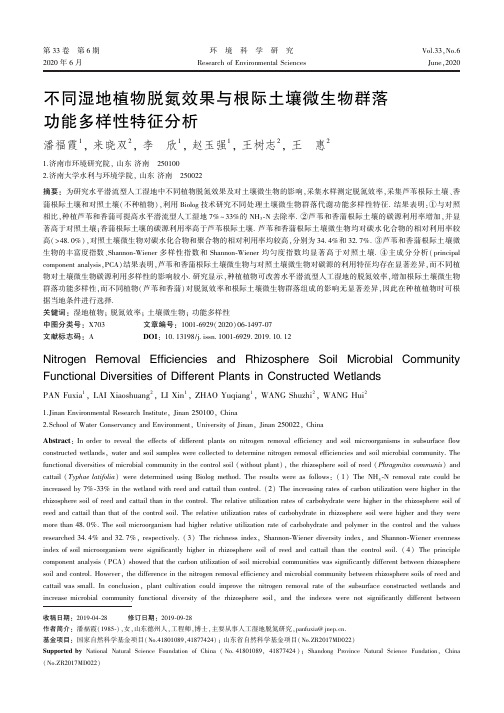
2.济南大学水利与环境学院ꎬ 山东 济南 250022
摘要: 为研究水平潜流型人工湿地中不同植物脱氮效果及对土壤微生物的影响ꎬ采集水样测定脱氮效率ꎬ采集芦苇根际土壤、香
蒲根际土壤和对照土壤( 不种植物) ꎬ利用 Biolog 技术研究不同处理土壤微生物群落代谢功能多样性特征. 结果表明:①与对照
Supported by National Natural Science Foundation of China ( No. 41801089ꎬ 41877424 ) ꎻ Shandong Province Natural Science Fundationꎬ China
( No.ZR2017MD022)
[7]
研究表明ꎬ88% ~ 96%的
硝态氮是通过微生物的反硝化过程去除的. HU 等
[8]
采用 N 同位素标记方法研究复合垂直流人工湿地
15
( 基质) 系统中氮去除提供理论基础.
Hale Waihona Puke 1 1 供试水平潜流型人工湿地
供试水平潜流型人工湿地位于济南市长清区的
NH 4 去除率ꎬ表明约 75 2% ~ 85 6% 的 NH 4 是通过
第 33 卷 第 6 期
环 境 科 学 研 究
2020 年 6 月
Research of Environmental Sciences
Vol.33ꎬNo.6
Juneꎬ2020
不同湿地植物脱氮效果与根际土壤微生物群落
功能多样性特征分析
潘福霞1 ꎬ 来晓双2 ꎬ 李 欣1 ꎬ 赵玉强1 ꎬ 王树志2 ꎬ 王 惠2
PAN Fuxia 1 ꎬ LAI Xiaoshuang 2 ꎬ LI Xin 1 ꎬ ZHAO Yuqiang 1 ꎬ WANG Shuzhi 2 ꎬ WANG Hui 2
利用磷脂脂肪酸表征白洋淀沉积物微生物特征

P o p o u o l e te l td n t e tfco o e m c ba imas n d a u d c n s dme s rn il h s h r s c ud b i e ur n a tr fr t h i m i h i r i bo s a b n a e i e i n .P cpe o l n t i
10 7 ) 0 8 5
摘要 : 以白洋 淀表 层沉 积 物为研 究 对象 , 磷脂 脂肪 酸(L A) 术 分析 了沉 积物 中微 生物 的生 物量 和群 落结 构. 果表 明, 层沉 积物 中 运用 PF 技 结 表
支链饱和脂肪酸含量最高, 细菌总数平均值为 4 4 l9 . x 0 个 ( 2 以干重计) , 是沉积物中微生物的主体. 厌氧细菌和革兰氏阳性菌是细菌的主要
Co r l t n a ay i i d c td t a tr d p h a r a e e t n e i n b c e i b o s a d id v ri . re ai o n l ss n i ae t wae e t h d g e t f c o s d me h t a tra i ma s n b o i e st l y
Ab t a t M i r b a i m a sa d c mmu i tu t r n s ra e s d me t fBay g in La e wee s d e t e sr c : c o ilb o s n o n t sr cu e i u f c e i n so i a d a k r t i d wi t y n u hh
白洋淀冰封期沉积物中氮赋存形态及分布特征
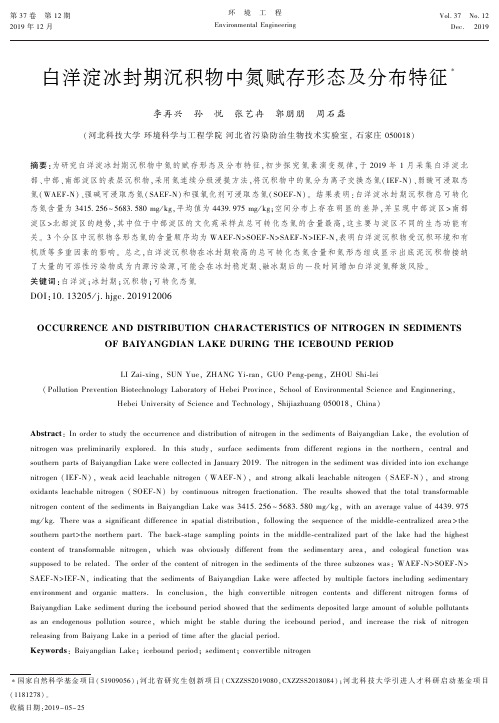
第37卷㊀第12期2019年12月环㊀境㊀工㊀程Environmental EngineeringVol.37㊀No.12Dec.㊀2019白洋淀冰封期沉积物中氮赋存形态及分布特征∗李再兴㊀孙㊀悦㊀张艺冉㊀郭朋朋㊀周石磊(河北科技大学环境科学与工程学院河北省污染防治生物技术实验室,石家庄050018)摘要:为研究白洋淀冰封期沉积物中氮的赋存形态及分布特征,初步探究氮素演变规律,于2019年1月采集白洋淀北部㊁中部㊁南部淀区的表层沉积物,采用氮连续分级浸提方法,将沉积物中的氮分为离子交换态氮(IEF-N )㊁弱酸可浸取态氮(WAEF-N )㊁强碱可浸取态氮(SAEF-N )和强氧化剂可浸取态氮(SOEF-N )㊂结果表明:白洋淀冰封期沉积物总可转化态氮含量为3415.256~5683.580mg /kg ,平均值为4439.975mg /kg ;空间分布上存在明显的差异,并呈现中部淀区>南部淀区>北部淀区的趋势,其中位于中部淀区的文化苑采样点总可转化态氮的含量最高,这主要与淀区不同的生态功能有关㊂3个分区中沉积物各形态氮的含量顺序均为WAEF-N>SOEF-N>SAEF-N>IEF-N ,表明白洋淀沉积物受沉积环境和有机质等多重因素的影响㊂总之,白洋淀沉积物在冰封期较高的总可转化态氮含量和氮形态组成显示出底泥沉积物接纳了大量的可溶性污染物成为内源污染源,可能会在冰封稳定期㊁融冰期后的一段时间增加白洋淀氮释放风险㊂关键词:白洋淀;冰封期;沉积物;可转化态氮DOI:10.13205/j.hjgc.201912006㊀㊀㊀㊀㊀㊀㊀㊀∗国家自然科学基金项目(51909056);河北省研究生创新项目(CXZZSS2019080,CXZZSS2018084);河北科技大学引进人才科研启动基金项目(1181278)㊂收稿日期:2019-05-25OCCURRENCE AND DISTRIBUTION CHARACTERISTICS OF NITROGEN IN SEDIMENTSOF BAIYANGDIAN LAKE DURING THE ICEBOUND PERIODLI Zai-xing,SUN Yue,ZHANG Yi-ran,GUO Peng-peng,ZHOU Shi-lei(Pollution Prevention Biotechnology Laboratory of Hebei Province,School of Environmental Science and Enginnering,Hebei University of Science and Technology,Shijiazhuang 050018,China)Abstract :In order to study the occurrence and distribution of nitrogen in the sediments of Baiyangdian Lake,the evolution ofnitrogen was preliminarily explored.In this study,surface sediments from different regions in the northern,central andsouthern parts of Baiyangdian Lake were collected in January 2019.The nitrogen in the sediment was divided into ion exchange nitrogen (IEF-N),weak acid leachable nitrogen (WAEF-N),and strong alkali leachable nitrogen (SAEF-N),and strong oxidants leachable nitrogen (SOEF-N)by continuous nitrogen fractionation.The results showed that the total transformablenitrogen content of the sediments in Baiyangdian Lake was 3415.256~5683.580mg /kg,with an average value of 4439.975mg /kg.There was a significant difference in spatial distribution,following the sequence of the middle-centralized area >thesouthern part>the northern part.The back-stage sampling points in the middle-centralized part of the lake had the highest content of transformable nitrogen,which was obviously different from the sedimentary area,and cological function was supposed to be related.The order of the content of nitrogen in the sediments of the three subzones was:WAEF-N>SOEF-N>SAEF-N>IEF-N,indicating that the sediments of Baiyangdian Lake were affected by multiple factors including sedimentaryenvironment and organic matters.In conclusion,the high convertible nitrogen contents and different nitrogen forms of Baiyangdian Lake sediment during the icebound period showed that the sediments deposited large amount of soluble pollutants as an endogenous pollution source,which might be stable during the icebound period,and increase the risk of nitrogenreleasing from Baiyang Lake in a period of time after the glacial period.Keywords :Baiyangdian Lake;icebound period;sediment;convertible nitrogen环㊀境㊀工㊀程第37卷0㊀引㊀言生态环境状况公报显示,我国绝大部分湖泊都处于水体富营养化状态或面临着水体富营养化的威胁㊂湖泊水体氮含量过高是造成水体富营养化的主要原因[1],水体中氮含量超标主要有2个方面:1)大量外源污染物持续不断地进入湖泊,在湖泊中积聚并超过其天然的自净能力,导致湖泊水质下降;2)随着外源污染物增多,水体中氮含量不断积累,通过沉降㊁扩散等形式汇入沉积物中,使得沉积物成为湖泊的氮储存库[2]㊂而沉积物中的氮可在湖泊流动㊁生物扰动㊁氧化还原环境改变的情况下,扩散到水体中,成为湖泊的内源污染物[3-6],造成湖泊水体的富营养化㊂根据现有文献发现,在对湖泊水质进行治理时,即使切断了湖泊水质的外源污染,沉积物中释放的氮素也有可能使得湖泊呈现出富营养化的状态[7,8]㊂因此,湖泊沉积物中氮含量及氮素赋存形态对于湖泊富营养化的治理具有重要意义㊂白洋淀作为华北平原最大的淡水湖泊,在维护华北地区生态系统平衡,调节华北平原乃至京津地区气候㊁补充地下水源㊁调蓄洪水以及保护生物多样性等方面发挥重要作用[9]㊂环保部于2017年将白洋淀㊁洱海㊁丹江口定义为新三湖[10],根据最新数据显示,洱海㊁丹江口水质为优,处于中营养状态,但白洋淀水质较差,处于轻度富营养状态[11-13]㊂若不对白洋淀水质加紧治理,白洋淀水质很有可能再次恶化,成为华北地区生态文明发展的重要制约因素㊂作为封闭性湖泊,白洋淀自身水体流动速度较为缓慢,多条入淀区河流受到的外源性污染物较多[14-15],尤其是贯穿整个保定市区的府河[16],受纳的污染物较多,外界的污染物随着府河汇入白洋淀,致使白洋淀水质受到严重威胁,而其他入淀区河流在冬季则呈现出断流情况㊂在此条件下,白洋淀冰封期上覆水的氮素很有可能进入沉积物中,在融冰期内源氮素大量释放,对白洋淀自身水环境造成重大威胁㊂因此,探明冰封期白洋淀沉积物的氮赋存形态及氮含量对于治理白洋淀沉积物内源污染有重大意义㊂1㊀材料与方法1.1㊀研究区概况及样品采集白洋淀(38ʎ46ᶄN~38ʎ59ᶄN,115ʎ47ᶄE~116ʎ6ᶄE)总面积达到362.8km2,淀区内主要由面积不等的143个淀泊和3700多条沟壕组成[17],地势较平坦,起伏不大,属海河流域大清河南支水系湖泊[17],自设立雄安新区后,白洋淀大部分为雄安新区所辖,成为雄安新区发展的重要生态水体㊂为了探究白洋淀冰封期沉积物氮素赋存形态及含量,将白洋淀分为北部㊁中部㊁南部3个部分,各采样点位置如图1所示㊂北部淀区包括S1烧车淀(旅游码头)㊁S2白沟引河采样点;中部淀区设置S3枣林庄㊁S4南刘庄府河入淀口㊁S5鸳鸯岛-旅游区㊁S6文化苑西门采样点;南部包括S7泛鱼淀㊁S8采蒲台北-环保点㊁S9前塘㊁S10后塘采样点,共设置10个采样点㊂于2019年1月对10个采样点的沉积物进行采集,将采集到的沉积物置于恒温箱内(5ħ),带回实验室低温真空干燥㊁研磨,过100目筛,处理后样品平行测定3次㊂图1㊀白洋淀采样点分布Fig.1㊀The sampling points distribution of Baiyangdian Lake 1.2㊀实验方法沉积物各形态氮采用逐级提取法[18,19],该方法将沉积物中可转化氮分为离子交换态氮(IEF-N)㊁弱酸可浸取态氮(WAEF-N)㊁强碱可浸取态氮(SAEF-N)和强氧化剂可浸取态氮(SOEF-N)4种形态,提取过程见表1,提取出的待测液采用纳氏试剂光度法测定NH+4-N,以N-(1-萘基)-乙二胺光度法测定NO-2-N,紫外分光光度法测定NO-3-N㊂2㊀结果与分析2.1㊀白洋淀沉积物总可转化态氮含量及空间分布特征白洋淀冰封期表层沉积物总可转化态氮含量为3415.256~5683.580mg/L,平均值为4439.975mg/L (图2),根据权重分析总可转化态氮含量总体表现为中部淀区>南部淀区>北部淀区㊂总可转化态氮含量03第12期李再兴,等:白洋淀冰封期沉积物中氮赋存形态及分布特征㊀㊀表1㊀沉积物可转化态氮分级连续浸提步骤Table 1㊀Grading continuous leaching procedure for the convertible nitrogen in sediment形态提取方法IEF-N 准确称取过100目筛的干燥沉积物样品1g 置于50mL 离心管中,加入1mol /L KC 溶液40mL,室温下振荡2h,离心10min(4000r /min),取上清液测定氮素含量WAEF-N 超纯水提取烘干上步残渣,加入40mL HAc-NaAc 溶液(pH =5),室温下振荡6h,离心10min(4000r /min),取上清液测定氮素含量SAEF-N 超纯水提取烘干上步残渣,加入0.1mol /L NaOH 溶液40mL,室温振荡17h,离心10min(4000r /min),取上清液调节pH 至7左右,测定氮素含量SOEF-N超纯水提取烘干上步残渣,加入40mL 碱性过硫酸钾溶液,室温振荡3h,放入高压灭菌锅消解1h,冷却后离心(4000r /min),取上清液调节pH 至7左右,测定氮素含量的最大值为S6采样点,该采样点主要位于白洋淀的旅游中心区,该区每日接纳的游客量巨大,随之产生的生活垃圾也与日俱增,导致水体中汇入大量外源污染物㊂在冰封期,水中含氮污染物随着水体的冻结沉入沉积物中,致使该采样点沉积物总可转化态氮含量升高㊂最小值为S8采样点,采蒲台北是白洋淀的环保示范点,2012 2014年采蒲台北水质由轻度富营养状态转为中营养状态[20],证明水质在逐年变好,且采蒲台北是白洋淀淀区水位最浅的淀区,内部水深只有5m,上覆水水质优良且水深较浅,使得沉积物接纳的外源污染物较少,进而可转化态氮含量较低㊂由此可见,沉积物中含有可转化态氮含量的高低与上覆水水质优良程度存在较为密切的关系㊂图2㊀白洋淀沉积物中总可转化态氮含量Fig.2㊀Total transformable nitrogen contents in BaiyangdianLake sediment总体来看,中部淀区的总可转化态氮含量最高,与王亚琼等[21]对白洋淀府河㊁旅游区中沉积物可转化态氮含量的研究结果一致㊂中部淀区的S4采样点,府河河流贯穿保定市区,保定市的生活污水和工业废水均排入府河流域,造成其接纳了大量外源污染物,同时该区域水体流动慢,自净能力较差,水质污染严重;S5和S6采样点均为白洋淀旅游业发达的淀区,淀内建有大型生态旅游景区,客流量巨大,配套餐饮服务行业也是主要的污染源,进而造成了2个淀区水质被污染严重㊂随着水质中污染物增多,在冰封期,河水结冰,大量氮源污染物汇集到沉积物表层,沉积物中可转化态氮含量升高㊂因此,中部淀区的总可转化态氮含量呈现出最高状态㊂2.2㊀白洋淀沉积物4种可转化态氮含量及变化特征不同采样点的各形态可转化态氮含量见图3㊂可明显得出:各采样点中不同形态的可转化态氮含量总体表现为WAEF-N >SOEF-N >SAEF-N >IEF-N㊂10个采样点中,WAEF-N 为沉积物碳酸盐结合态氮㊁黏土矿物中部分结合态氮,属于易释放态氮,其含量为2809.12~3084.87mg /kg,占总可转化态氮含量的54.28%~82.25%㊂S4采样点的WAEF-N 含量最高,可能是S4不仅承接了保定市居民生活污水,上游污水处理厂的废水也排入其中,汇入的外源污染物较多,进而沉降到沉积物中的污染物也随之增多㊂10个采样点均表现出高含量的WAEF-N,可能是近期汇入淀中的污染物较多,在冰封期,氮污染物通过沉降㊁扩散到沉积物中,在融冰期释放,将会对白洋淀水质造成巨大的威胁㊂SOEF-N 是指与有机质和硫化物结合的氮形态[22],主要是有机氮,是释放能力最弱的氮形态㊂白洋淀冰封期沉积物中ω(SOEF-N )为312.34~1620.85mg /kg,占总可转化态氮含量的9.05%~28.52%㊂S6采样点的SOEF-N 含量最高,可能是在冰封期来临前,人类频繁的水上活动导致该点水位明显下降,使得沉积物与O 2进行接触,微生物大量繁殖导致SOEF-N 形态的氮含量上升;SAEF-N 为NaOH 可浸提的固定态氮及Fe /Mn /Al 氧化物结合态氮[19],水体中溶解氧的含量与SAEF-N 存在负相关关系,即随着溶解氧的升高,SAEF-N 会向其他形态的氮素转化,白洋淀沉积物ω(SAEF-N)为112.8~1174.47mg /kg,占总可转化态氮含量的3.3%~20.66%㊂S8采样点的SAEF-N 含量最低,可能是其13环㊀境㊀工㊀程第37卷水质较优良,水体中溶解氧含量较高,因此沉积物中SAEF-N 形态的氮含量较低;IEF-N 是可转化态氮中最 活跃 的氮形态[23,24],随着水位升高降低㊁水流快慢㊁沉积物受水生动物的扰动速度,极易在沉积物-水界面进行迁移转化,在沉积物中结合能力最弱,白洋淀沉积物中ω(IEF-N)最低,为57.42~230.41mg /kg,占总可转化态氮含量的1.68%~8.59%㊂S1采样点该种类型的氮含量最低,S1是白洋淀旅游区的水上码头,过往的船只对水体搅动引起底层沉积物的翻动,导致IEF-N 被扩散,因此检测出该采样点离子交换态氮含量最低㊂IEF-N;WAEF-N;SAEF-N;SOEF-N㊂图3㊀白洋淀沉积物中4种可转化态氮含量分布Fig.3㊀Distribution of four transformable nitrogen contents in sedimentsof Baiyangdian Lake此外,白洋淀各淀区的4种可转化态氮含量差异较大,北部采样点包括入淀河流㊁旅游淀区,中部采样点包括居民生活区㊁旅游发达区㊁入淀区河流,南部采样点包括环保示范区㊁养殖淀区以及居民生活区,每个采样点基本涵盖了白洋淀整个淀区的承载功能㊂造成每个采样点中4种可转化态氮含量差异的原因一方面可能是各淀区承载功能不同,污染物来源不同;另一方面,据历史记载,白洋淀曾出现2次干涸时期[25,26],使得入淀径流和淀内蓄水都发生变化,从而使得沉积物中4种可转化态氮含量存在较大差异㊂2.3㊀白洋淀沉积物氮形态特征白洋淀冰封期沉积物的ω(TN )为6710.178~12470.202mg /kg(图4a)㊂其中,南部淀区的TN 含量达到最高,与总可转化态氮变化趋势相似,TN 由总可转化态氮和非总可转化态氮2部分组成,总可转化态氮占TN 的35.54%~76.35%(图4b),S4采样点中总可转化态氮的占比值最高为76.35%㊂根据龙幸幸等[16]对白洋淀府河水质污染程度研究可知,府河内部汇入了大量生活垃圾及工业废水,水质污染最为严重㊂因此,在白洋淀结冰期,府河水质中的氮污染物汇入沉积物中,造成沉积物TN 中可转化态氮含量随之升高,占比最大㊂图4㊀白洋淀沉积物中TN 含量分布及总可转化态氮(TTN)/TNFig.4㊀Distribution of TN contents and total convertible nitrogen(TTN)/TN in sediments of Baiyangdian Lake根据分区探究及图4可知:随着北部㊁中部㊁南部淀区TN 升高,总可转化态氮的占比并没有升高,反而呈现出减少的趋势,这说明TN 的增加主要是来自非可转化态氮含量的升高㊂与李鑫[27]对于沉积物中氮形态分布的研究结果相一致,原因主要是随着沉积物被污染程度的加深,沉积物中的氮逐渐向稳定性强的形态发展[22]㊂根据白洋淀自身的水文状态分析,白洋淀是封闭性湖泊,自身水体流动较慢,除入淀区河流能大量接纳外源污染物外,其他淀区沉积物受到的污染主要来自自身水体污染和藻类物质的腐烂㊂随着时间的积累,活泼的氮形态向稳定态转化,但在进入融冰期后,水生植物生长以及河水流动可能会搅动沉积物,使得内部氮素大量释放,可能会增加水体富营养化的风险㊂23第12期李再兴,等:白洋淀冰封期沉积物中氮赋存形态及分布特征3 结论与建议1)白洋淀冰封期沉积物总可转化态氮含量为3415.256~5683.580mg/kg,总可转化态氮在各采样点中差异较大㊂根据10个采样点分析,S6采样点的总可转化态氮含量最高,主要是因为发达的旅游业造成餐饮垃圾大量增多㊂由于每个淀区承载的功能不同,整体表现出中部淀区>南部淀区>北部淀区的趋势,中部淀区中旅游业的发展是造成总可转化态氮含量升高的主要原因㊂2)10个采样点的4种可转化态氮含量变化趋势均表现为WAEF-N>SOEF-N>SAEF-N>IEF-N,WAEF-N 是较易释放态氮,高含量的WAEF-N可能在融冰期大量释放到上覆水中,造成白洋淀水质污染严重㊂3)白洋淀沉积物ω(TN)为6710.178~ 12470.202mg/kg,可转化态氮占35.54%~76.35%㊂除S4采样点占比最高,其余采样点占比均在50%以下,根据数据发现沉积物中TN的组成主要是非可转化态氮㊂由此可见,白洋淀冰封期沉积物高含量TN 主要是非总可转化态氮含量造成的㊂致谢:感谢周石磊老师在2019年1月采集白洋淀沉积物以及对实验流程的指导,感谢张艺冉㊁郭朋朋等在实验指标测定中的帮助㊂参考文献[1]㊀Conley D J,Paerl H W,Howarth R W,et al.Ecology.Controlling eutrophication:nitrogen and phosphorus[J].Science,2009,323(5917):1014-1015.[2]㊀金相灿,王圣瑞,姜霞.湖泊水-沉积物界面三相结构模式的初步研究[J].环境科学研究,2004,17(增刊1):1-5,10.[3]㊀Li Z J,Yue Q Y,Gao B Y,et al.Phosphorus release potentialand pollution characteristics of sediment in downstream NansiLake,China[J].Frontiers of Environmental Science andEngineering,2012,6(2):162-170.[4]㊀Vicente I D,Serrano L,Amores V,et al.Sediment phosphatefractionation and interstitial water phosphate concentration in twocoastal lagoons(Albuferas de Adra,SE Spain)[J].Hydrobiologia,2003,492(1/2/3):95-105.[5]㊀Sndergaard M,Jensen J P,Jeppesen E.Role of sediment andinternal loading of phosphorus in shallow lakes[J].Hydrobiologia,2003,506/509(1/2/3):135-145.[6]㊀Petticrew E L,Arocena J M.Evaluation of iron-phosphate as asource of internal lake phosphorus loadings[J].Science of theTotal Environment,2001,266(1):87-93.[7]㊀Jeppesen,Meerhoff,Jacobsen,et al.Restoration of shallow lakesby nutrient control and biomanipulation-the successful strategyvaries with lake size and climate[J].Hydrobiologia,2007,581(1):269-285.[8]㊀Nrnberg G K,Tarvainen M,Vente A M,et al.Internalphosphorus load estimation during biomanipulation in a largepolymictic and mesotrophic lake[J].Inland Waters,2012,2(3):147-162.[9]㊀朱曜曜,金鑫,孟鑫,等.白洋淀沉积物氨氮释放通量研究[J].环境科学学报,2018,38(6):2435-2444. [10]㊀曹晓峰.基于HJ-1A/1B影像的滇池水质遥感监测研究[D].西安:西安科技大学,2012.[11]㊀崔秀丽.白洋淀水体富营养化污染源调查[J].环境科学,1995,16(增刊1):17-18.[12]㊀项颂,庞燕,窦嘉顺,等.不同时空尺度下土地利用对洱海入湖河流水质的影响[J].生态学报,2018,38(3):876-885.[13]㊀谭浩强,何文杰,陆颖臣,等.丹江口水库水质的综合评价[J].供水技术,2016,10(2):1-7.[14]㊀金磊,李林钰,周杨,等.白洋淀三大典型水域浮游植物群落及水质评价[J].河北大学学报(自然科学版),2017,37(3):329-336.[15]㊀张铁坚,王朦,彭艳侠,等.白洋淀上游城市内河浮游动物群落调查与水质评价[J].环境工程,2016,34(3):166-169.[16]㊀龙幸幸,杨路华,夏辉,等.白洋淀府河入淀口周边水质空间变异特征分析[J].水电能源科学,2016(9):35-38. [17]㊀程磊.白洋淀水环境现状分析[J].水科学与工程技术,2016(5):50-52.[18]㊀沈洪艳,张绵绵,倪兆奎,等.鄱阳湖沉积物可转化态氮分布特征及其对江湖关系变化的响应[J].环境科学,2015,35(1):87-93.[19]㊀Ruttenberg K C.Development of a sequential extraction method fordifferent forms of phosphorus in marine sediments[J].Limnology&Oceanography,1992,37(7):1460-1482.[20]㊀阳小兰,张茹春,毛欣,等.白洋淀水体氮磷时空分布与富营养化分析[J].江苏农业科学,2018,46(24):370-373. [21]㊀王亚琼,薛培英,耿丽平,等.白洋淀沉积物-沉水植物-水系统氮㊁磷分布特征[J].水土保持学报,2017,31(3):304-309.[22]㊀何桐,谢健,余汉生,等.大亚湾表层沉积物中氮的形态分布特征[J].热带海洋学报,2009,28(2):86-91. [23]㊀张亚楠.东昌湖表层沉积物氮赋存形态及其释放研究[D].青岛:中国海洋大学,2013.[24]㊀Wang P F,Li Z,Chao W,et al.Nitrogen distribution andpotential mobility in sediments of three typical shallow urban lakesin China[J].Environmental Engineering Science,2009,26(10):1511-1521.[25]㊀赵晓辉,孙中孚.白洋淀干淀原因分析[J].河北水利,2006(11):38-39.[26]㊀邱琳.白洋淀干淀原因与对策分析[J].水科学与工程技术,2017(4):38-41.[27]㊀李鑫.浅水湖泊沉积物中氮的迁移转化机制研究[D].天津:天津大学,2012.第一作者:孙悦(1993-),女,硕士,主要研究方向为水污染控制及好氧反硝化脱氮㊂hbkjdxsy@通信作者:周石磊(1987-),男,博士,讲师,主要研究方向为水质微污染控制与水资源保护㊂zslzhoushilei@33。
北运河流域(北京段)表层土壤多环芳烃空间分布特征及来源解析

北运河流域(北京段)表层土壤多环芳烃空间分布特征及来源解析北运河流域(北京段)表层土壤多环芳烃空间分布特征及来源解析摘要:多环芳烃(PAHs)是一类对环境和人类健康有害的化学物质,其分布特征和来源解析对于环境污染防治具有重要意义。
本文通过对北运河流域(北京段)表层土壤中PAHs的采样和分析,研究了其空间分布特征以及可能的来源解析。
结果表明,北运河流域的土壤中普遍存在PAHs,其中主要的污染物为苯并[a]芘、苯并[ghi]苝和芘,其浓度范围为X-XX ng/g。
研究还发现,PAHs的分布呈现出明显的空间差异,主要受到工业和交通活动的影响。
此外,通过相关性分析和PAHs组成特征,可以推测其来源主要包括机动车尾气排放、燃煤排放和生物质燃烧排放。
引言:近年来,随着城市化进程的加速和工业发展的快速推进,PAHs 在环境中的含量不断增加。
PAHs是许多活动产生的有机污染物的重要成分,来源广泛,包括石油和煤炭的燃烧、机械加工、生物质燃烧等。
这些物质对环境和人类健康具有潜在的威胁,因此对其分布特征和来源进行深入研究至关重要。
方法:本研究选择北运河流域(北京段)作为研究对象,共采集了30个样品,每个样品的深度为0-20厘米。
采样点布置在工业区、交通枢纽周边和农田等不同类型的区域,以考察PAHs的空间分布特征。
采用气相色谱-质谱联用技术(GC-MS)对采样物进行分析,通过比对峰面积和标准品浓度计算出PAHs的含量。
结果与讨论:结果显示,北运河流域(北京段)表层土壤中普遍存在PAHs,主要污染物为苯并[a]芘、苯并[ghi]苝和芘。
这些PAHs的浓度范围为X-XX ng/g,部分样品的浓度超过了环境质量标准。
空间分布图显示,工业区和交通枢纽周边的土壤中PAHs的含量普遍高于农田区。
这说明工业和交通活动是PAHs的主要来源之一。
同时,通过相关性分析发现,PAHs之间存在一定的相关性,这也表明它们可能来自共同的污染源。
另外,通过比较PAHs的组成特征,可以进一步推测其主要来源。
微生物脱氮原理

微生物脱氮原理微生物脱氮呀,就像是一场超级神奇的魔法表演呢。
咱先来说说氮在环境里的情况。
氮这个元素呀,在自然界里到处晃悠。
有一些氮是以氮气的形式存在于空气中的,氮气就像个超级淡定的家伙,不怎么爱和别的物质打交道。
但是呢,在水体或者土壤里,氮就变得活跃起来了,它会以各种形式存在,像氨氮呀、硝态氮之类的。
如果氮太多了,那可就麻烦了,就好比一场聚会来了太多不请自来的客人,会把环境这个派对搞砸的。
比如说在水里,氮太多会让水变得富营养化,水藻就会疯长,然后水就变得脏兮兮的,鱼呀虾呀都不开心了。
这时候呢,微生物就闪亮登场啦。
微生物可是小小的大英雄哦。
有一种微生物叫硝化细菌,它可厉害了呢。
硝化细菌里又分成两类,一类叫氨氧化细菌,就像氮的小管家一样。
氨氧化细菌看到氨氮的时候,就像看到了自己要改造的小目标。
它会把氨氮变成亚硝态氮,这个过程就像是把一块粗糙的石头初步打磨成一个有点形状的小物件。
然后呢,另一种硝化细菌,叫亚硝酸盐氧化细菌,它就接手了这个亚硝态氮,再把它变成硝态氮。
这就好比是把那个初步打磨的小物件进一步精雕细琢成一个精致的工艺品。
但是呀,这还没完呢。
还有一群微生物叫反硝化细菌。
反硝化细菌就像是一群小魔法师,它们专门和硝态氮过不去。
反硝化细菌在缺氧的环境里可活跃了,它们会把硝态氮一点点变成氮气。
这个过程就像是把那些已经加工好的工艺品又重新打散,变回最原始的材料,然后把这个氮气送回空气中,就像把不想要的东西打包送回原处一样。
微生物脱氮的过程其实也很依赖环境的。
就像微生物们住在一个小社区里,环境就是它们的房子和生活设施。
如果这个环境里氧气太多了,那反硝化细菌就会不开心,它们的魔法就施展不出来了。
而如果没有足够的碳源呢,就像微生物们没有足够的食物,它们也没办法很好地进行脱氮工作。
所以呀,我们要是想让微生物好好地进行脱氮,就得给它们创造一个舒适的小环境,就像给小宠物准备一个温暖舒适的小窝一样。
微生物脱氮在污水处理厂可是超级明星呢。
海河流域流氮污染特征及规律

海河流域流氮污染特征及规律1 引言氮素是植物生长最重要的营养元素之一,决定着淡水生态系统中浮游植物的生长和分布.总氮(TN)、氨氮(NH4+-N)、硝氮(NO3--N)和亚硝氮(NO2--N)是水生态系统中氮素的最主要存在形态,过量的氮输入会造成水体酸化、富营养化以及毒性等副作用,危害水体的生态系统健康.近年来,由于我国经济快速发展,含有高浓度氮素的工业废水和生活污水排入河流,造成水质恶化和水体富营养化.氮素超标已经成为我国河流的主要水污染问题,严重影响河流水环境质量.我国“十二五”规划中明确提出将氨氮作为污染减排的约束性指标,这也将是今后我国河流氮污水控制的指导方向.海河流域地处我国的政治文化中心,在我国的社会经济发展中有着举足轻重的作用.近几十年来,流域经济社会发展迅速,点源污染和非点源污染剧增.2010年流域工业废水排放量高达23.15亿t,主要的排污行业为化工、造纸、电力、食品、冶金等行业,这5个行业的废水排放量占全部工业废水排放量的一半以上,主要污染物为化学耗氧量、挥发酚、氨氮等;2007年,全流域畜禽养殖产生污染物氨氮45.42万t,总氮116.53万t,入河污染物总氮0.83万t、氨氮0.58万t;2007年农业非点源入河污染物总氮8.6万t,氨氮1.1万t,入河系数分别为总氮0.15、氨氮0.18,这些污染物的排放正加剧着海河流域河流水体氮污染.已有研究表明,海河流域子牙河水系河流整体氮污染严重,以氨氮为特征污染物,超过国家地表水环境质量标准(GB3838-2002)V标准(;氨氮和亚硝酸盐氮是海河干流的2个主要污染因子.目前的研究缺乏从整个流域层面分析河流的氮污染状况,难以对氮污染演变过程与发展趋势形成全面的认识.本研究利用海河流域河流主要监测站点数据与实测数据,分析TN、NH4+-N、NO3--N 和NO2--N的污染特征和演变趋势,以期为流域水污染控制和水生态修复提供基础和依据.2 研究区域与数据2.1 研究区域概况海河流域位于东经112°~120°,北纬35°~43°,流域总面积31.8万km2.海河流域属温带半干旱、半湿润季风气候区,年平均气温0~14 ℃,多年平均降水量547 mm.按照地貌条件可以将海河水系划分为上游山区段、中部平原段和下游滨海段.流域由滦河、北三河(北运河、潮白河和蓟运河)、永定河、大清河、海河干流、子牙河、黑龙港运东、漳卫河以及徒骇马颊河九大水系构成,其中以北三河、永定河、大清河和海河干流为海河北系,以子牙河、黑龙港运东、漳卫河为海河南系.整个海河流域的水系从南到北呈扇形分布,整体上具有次级水系分散、河系复杂、支流众多、过渡带短、源短流急的特点.海河流域囊括了北京、天津、河北、山西、山东、河南、内蒙古、辽宁8个省、自治区、直辖市的全部或部分地区,其中,“京-津-冀”地区是我国重要的政治、经济、文化中心,具有重要的战略地位.经济社会发展迅速、人口密度较高是海河流域的鲜明特征.海河流域水资源短缺,水环境承载能力相对较低.1998年至2010年,流域年均地表水资源量为118亿m3,人均总水资源占有量仅为全国平均的1/7,是我国七大江河流域中水资源最匮乏的地区.流域内人口急剧膨胀及经济快速发展,导致对水资源开发利用程度逐步提高,水资源开发利用率已经接近100%.海河流域是我国水质污染最为严重的区域,大量的工业废水、生活污水进入河流系统,生态环境严重恶化.氮磷等元素随废污水排放进入河流,导致海河流域主要河流营养盐普遍超标.水资源总量少且时空分布不均、开发利用程度过高、水质污染严重,是海河流域最为突出的水环境问题.2.2 数据与方法2.2.1 氮素分析方法海河流域氮素数据调查采用地统计调查方法,通过流域网格化和采样点筛查共确定采样点350个(图 1),调查采样时间为2009年7月至同年10月.采样方法及样品的预处理方法按照水和废水监测分析方法完成,车载冰箱保存样品,带回实验室进行分析.氮素测定指标为总氮、氨氮、硝态氮、亚硝态氮,其中,总氮:碱性过硫酸钾氧化-紫外分光光度法;氨氮:纳氏试剂分光光度法;硝态氮:酚二磺酸分光光度法;亚硝态氮:N -(1-萘基)-乙二胺分光光度法.2.2.2 历史数据的收集与数据分析水质历史演变趋势的分析以2000—2011年海河流域重点水功能区主要监测站点的监测数据(海河流域水资源保护局提供)以及2009年的实测数据为依据.历史数据的分析,首先将历年来的主要监测站点数据按照九大水系进行划分,取每个水系水体环境因子的平均值进行对比;水质评价方法,采用水质类别判定法即单因子评价法,根据地表水环境质量标准中规定的污染指标限值与监测值比较;氮污染物空间分布分析在ArcGis 10.1中完成,空间差值方法采用IDW(Inverse Distance Weighted)方法;氮污染物相关性分析在SPSS 19中完成.3 结果与分析3.1 河流氮污染空间分布特点及污染现状海河流域氮污染严重,各种形态的氮浓度呈现出沿山区-平原方向有上升趋势的显著空间分布特征(图 2).海河流域河流水体氮污染最严重的区域集中在中部平原地区,主要超标污染物为NH4+-N,NH4+-N是氮污染的主要污染因子;山区段TN、NO3--N和NO2--N含量较高,NH4+-N则在平原地区含量相对较高.海河干流水系、北三河水系和子牙河水系是海河流域氮污染最严重的区域.就各种氮素空间分布区域而言,TN平均浓度较高的区域主要分布在海河干流水系、黑龙港运东水系、子牙河水系和北三河水系,平均浓度均超过了9.00 mg · L-1;NH4+-N平均浓度较高的区域主要分布在海河干流水系、北三河水系和子牙河水系,平均浓度均超过了5.00 mg · L-1; NO3--N平均浓度较高的区域主要分布在海河干流、黑龙港运东和子牙河水系,平均浓度均超过了2.00 mg · L-1;NO2--N平均浓度较高的区域主要分布在北三河水系和徒骇马颊河水系.海河流域氮污染现状仍然严重.2011年,海河流域河流水体中TN平均浓度为7.92mg · L-1,超过国家地表水V标准限值(2 mg · L-1)4倍,超标现象严重;TN平均浓度最高的是海河干流水系,为15.55 mg · L-1,超过地表水V标准限值7倍以上,最高值为23.3 mg · L-1;滦河水系河流水体中TN浓度相对最低(2.78 mg · L-1),略高于地表水V标准限值.NH4+-N平均浓度4.25 mg · L-1,超过地表水V水质标准限值(2 mg · L-1)2.1倍,是河流水体中氮污染物的主要存在形式;海河干流水系NH4+-N平均浓度最高,为11.52 mg · L-1,超过地表水V 标准限值5倍以上;最低值出现在滦河水系,平均浓度仅为1.62 mg · L-1,略高于地表水IV 类标准限值(1.5 mg · L-1).NO3--N平均浓度为1.28 mg · L-1,是水体中含量较低的一种氮素;海河干流水系NO3--N平均浓度最高为4.66 mg · L-1.NO2--N平均浓度0.013 mg · L-1,是海河流域河流水体中含量最低的一种氮素.一般天然水体中NO2--N不超过0.1 mg · L-1,NO2--N平均浓度高于0.1 mg · L-1的区域主要分布在北三河水系和徒骇马颊河水系.3.2 河流氮污染变化趋势2000—2011年,海河流域河流水体中TN、NH4+-N、NO3--N、NO2--N多年变化趋势见图 3.2000年至2005年TN浓度逐渐升高,在2005年达到一个峰值为8.99 mg · L-1,2009年明显下降,2009—2011年又逐渐升高,在2011年达到另一个峰值为7.92 mg · L-1;TN平均浓度最高为2005年的8.99 mg · L-1,最低为2000年的3.34 mg · L-1.NH4+-N浓度变化整体上呈现出与TN 浓度变化相似的变化趋势,在2005年和2011年达到峰值,浓度分别为5.46 mg · L-1和4.25mg · L-1,NH4+-N浓度最低为2000年的2.67 mg · L-1.2002—2010年,海河流域河流水体中NO3--N浓度基本保持稳定,2011年浓度最低,平均浓度为1.34 mg · L-1,2005年浓度最高,平均浓度为2.89 mg · L-1.NO2--N浓度呈现随年份显著降低的趋势,最高为2000年的1.76 mg · L-1.从氮素多年变化趋势来看,NH4+-N仍然是TN的主要贡献者,也是造成海河流域氮污染严重的关键因子.通过Spearman相关性分析(表 1),海河流域河流水体中TN浓度与NH4+-N、NO3--N、NO2--N 浓度呈现显著正相关(p<0.01),TN浓度与NH4+-N浓度的变化趋势最为接近(图 3),说明NH4+-N 浓度变化对TN浓度变化的影响最大;NH4+-N浓度与NO3--N浓度呈现显著负相关(p<0.05),可能由于水体当中的氧化还原条件促使NH4+-N与NO3--N之间发生了相互转化;NO2--N浓度与NH4+-N、NO3--N浓度均呈现显著正相关(p<0.01),NO2--N是氮循环的中间产物,不稳定,可被氧化成NO3--N,在厌氧环境中也可受微生物的作用被还原为NH4+-N.2000—2011年,NH4+-N劣V(>2.0 mg · L-1)站点比例整体上表现为减少趋势(表 2),由2000年的28.87%降为2011年的17.56%;劣V类站点NH4+-N浓度均值呈现整体下降的趋势,由2000年的7.91 mg · L-1降为2011年的6.50 mg · L-1;海河流域河流水体中NH4+-N浓度达到V类水质标准的站点比例整体表现为增加的趋势,由2000年的71.13%增加到2011年的82.44%,达IV类水质标准的站点比例由2000年的69.87%增加到2011年的80.38%;至2011年,海河流域河流水体中NH4+-N浓度达III类水质标准的站点比例为75.79%,较2000年增加了13.87%.海河流域呈现出氨氮污染减轻,向IV、V甚至更高水质标准转变的趋势.海河流域九大水系中,滦河、永定河、大清河和北三河水系河流水体中NH4+-N 浓度没有明显的降低趋势,子牙河、漳卫河、海河干流、黑龙港运东水系河流水体中NH4+-N浓度随年份降低程度较大(图 4).黑龙港运东水系河流NH4+-N污染最重,2000—2011年,黑龙港运东水系河流水体中NH4+-N平均浓度为9.30 mg · L-1,超过了V类水质标准,超标倍数在1.6~8.8之间.其中,2001年NH4+-N平均浓度最高,为17.64 mg · L-1,2011年最低,为1.96 mg · L-1.子牙河水系河流水体中NH4+-N污染较重,2000—2011年,子牙河水系河流水体中NH4+-N平均浓度为11.91 mg · L-1,超过地表水V类水质标准,超标倍数为2.7~23.2,其中2000年NH4+-N平均浓度最高,为46.33 mg · L-1.滦河水系河流水体中NH4+-N污染较轻,2000—2011年,滦河水系河流水体中NH4+-N平均浓度为2.67 mg · L-1,超过地表水V类水质标准,超标倍数在1.3~3.4之间,其中2005年NH4+-N平均浓度最高,为6.72 mg · L-1,2011年降至1.10 mg · L-1.永定河、大清河水系河流水体中的NH4+-N含量最低,除个别年份外均在V 类水质标准以内.2000—2011年,永定河水系河流水体中NH4+-N平均浓度为1.55 mg · L-1,在V类水质标准范围内,其中2007年NH4+-N平均浓度最高,为2.34 mg · L-1,2009年最低,为0.69 mg · L-1;2000—2011年,大清河水系河流水体中NH4+-N平均浓度为0.35 mg · L-1,在地表水Ⅱ类水质标准范围内,其中2000年NH4+-N平均浓度最高,为0.52 mg · L-1,2001年最低为0.16 mg · L-1.2007—2011年,海河流域河流NH4+-N污染整体上呈现好转趋势,但超标现象仍较严重.其中,NH4+-N仍超标较严重的站点包括大清河的龙王庙,超V类水质标准2~5倍;潮白河的赶水坝,超V类水质标准5~9倍;沟河的双村,超V类水质标准2~10倍;温榆河的土门楼,超V类水质标准5~8倍;温榆河的白庄桥,超V类水质标准2~5倍;漳卫新河的第三店,超V类水质标准2~16倍;徒骇河的大清集,超V类水质标准2~13倍.4 讨论以COD和NH4+-N为主导的耗氧污染仍然是海河流域河流的首要污染问题.氨氮硝化耗氧过程是河流生态系统中氮循环的重要环节,其对河流溶解氧消耗的贡献比例最大能达到81%,这一耗氧效应将会严重影响到水体中的溶氧平衡,使水体发黑发臭.氨氮也是水体中重要的营养物质,可为藻类生长提供营养源,过量的氮会引起藻类大量繁殖,形成水体富营养化.氨氮可对水生生物产生毒害作用,起毒害作用的主要是非离子氨1.非离子氨对河流水生生物,尤其是鱼类具有毒害效应.以海河流域2009年地表水水质数据为基础,根据美国淡水氨氮浓度标准值,计算流域氨氮产生的非离子氨毒害效应阈值.结果显示,氨氮最大浓度基准值(CMC)为1.593 mg · L-1,持续浓度基准值(CCC)为0.219 mg · L-1.整个海河流域由氨氮产生的非离子氨毒害效应严重,氨氮浓度超过CCC河段长度占整个评价河段长度(15941 km)的86%,各水系氨氮浓度超过CMC的河长比例均超过40%.滦河水系下游、北三河水系下游、海河干流水系、子牙河水系、漳卫河水系的平原区和滨海区氨氮浓度均超过CMC浓度.在一个流域内,河岸两边的植被类型、人口数量和工业布局是影响河流氮污染的重要原因.海河流域山区段林草地广泛分布,基本无污染源,水质较好,氮污染较轻.平原段氮素浓度较高,分析原因是海河流域平原区绝大部分为农田、城镇和农村聚落,分布着各大中型城市,人口密集,工业发达,工业废水与生活污水排放量大,同时农田面积大,化肥流失严重,畜禽养殖规模较大,氮、磷等污染物入河系数高.工业污染、农业面源污染与畜禽养殖污染排放入河的大量污染物是造成海河流域氮污染严重的主要原因.海河流域河流氮污染现状仍然严重的同时,污染整体却呈现好转的趋势,尤其2009年以来,TN与NH4+-N浓度整体下降,NH4+-N劣V类站点比例逐渐减少.海河流域“十一五”水专项的组织实施与城镇污水处理率的提高是氮污染好转的主要原因.国家“水专项”在“十一五”期间组织实施了海河流域水环境质量改善项目,以消减污染负荷(降低COD、氨氮、总氮、总磷排放总量)、控制水污染趋势、改善区域水环境质量为关键指标,重点开展了产业水污染、城市水污染的治理以及非常规水资源(再生水、雨水、浅层微咸地下水)的开发利用.至2009年,海河流域已建成并投入运行的城镇污水处理厂有307座,总处理能力达1610万t · d-1,分别占全国的15.4%和16.00%;非常规水资源利用量为11.06亿m3,较2000年增加了204.7%.全流域污水处理率以及非常规水资源利用的增加促进了海河流域河流氮污染状况的改善.5 结论1)海河流域氮污染现状仍然严重,2011年TN、NH4+-N、NO3--N和NO2--N平均浓度分别为7.92、4.25、1.28、0.013 mg · L-1,超标现象严重.在空间分布上,氮污染呈现出明显的沿山区-平原方向上升的分布特征,污染较重的区域主要集中在海河干流水系、北三河水系和子牙河水系.2)海河流域河流水体中TN浓度与NH4+-N、NO3--N、NO2--N浓度呈现极显著正相关(p<0.01),TN浓度的变化趋势受到NH4+-N、NO3--N、NO2--N浓度的很大影响,其中受NH4+-N浓度变化的影响较大.3)NH4+-N是海河流域氮污染的主要污染因子,NH4+-N浓度变化趋势整体上表现为劣V类站点比例逐渐减少,由2000年的28.87%降为2011年的17.56%,劣V类站点NH4+-N的平均浓度由2000年的7.91 mg · L-1降为2011年的6.50mg · L-1,向IV、V类甚至更高水质标准转变.具体参见污水宝商城资料或更多相关技术文档。
常规生物脱氮原理及好氧颗粒污泥脱氮应用特点
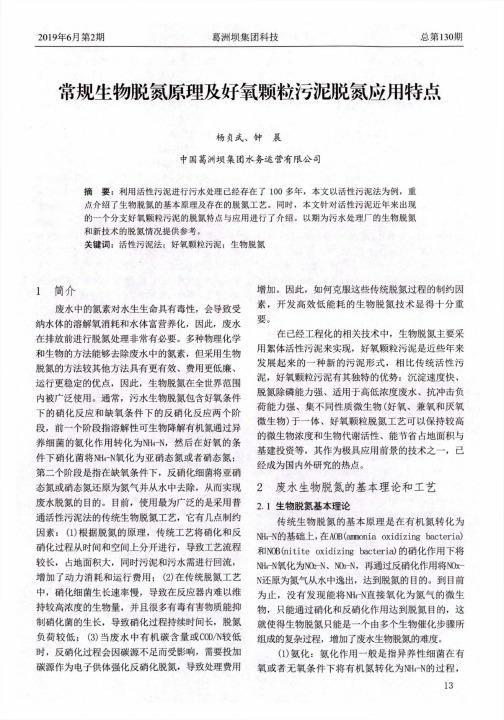
2019年6月第2期葛洲坝集团科技总第130期常规生物脱氮原理及好氧颗粒污泥脱氮应用特点杨贞武、钟晨中国葛洲坝集团水务运营有限公司摘要:利用活性污泥进行污水处理已经存在了100多年,本文以活性污泥法为例,重点介绍了生物脱氮的基本原理及存在的脱氮工艺。
同时,本文针对活性污泥近年来出现的一个分支好氧颗粒污泥的脱氮特点与应用进行了介绍。
以期为污水处理厂的生物脱氮和新技术的脱氮情况提供参考。
关键词:活性污泥法;好氧颗粒污泥;生物脱氮1简介废水中的氮素对水生生命具有毒性,会导致受纳水体的溶解氧消耗和水体富营养化,因此,废水在排放前进行脱氮处理非常有必要。
多种物理化学 和生物的方法能够去除废水中的氮素,但采用生物脱氮的方法较其他方法具有更有效、费用更低廉、运行更稳定的优点,因此,生物脱氮在全世界范围内被广泛使用。
通常,污水生物脱氮包含好氧条件下的硝化反应和缺氧条件下的反硝化反应两个阶段,前一个阶段指溶解性可生物降解有机氮通过异养细菌的氨化作用转化为NH4-N,然后在好氧的条件下硝化菌将NH4-N氧化为亚硝态氮或者硝态氮;第二个阶段是指在缺氧条件下,反硝化细菌将亚硝态氮或硝态氮还原为氮气并从水中去除,从而实现废水脱氮的目的。
目前,使用最为广泛的是采用普通活性污泥法的传统生物脱氮工艺,它有几点制约因素:(1)根据脱氮的原理,传统工艺将硝化和反硝化过程从时间和空间上分开进行,导致工艺流程较长,占地面积大,同时污泥和污水需进行回流,增加了动力消耗和运行费用;(2)在传统脱氮工艺中,硝化细菌生长速率慢,导致在反应器内难以维持较高浓度的生物量,并且很多有毒有害物质能抑制硝化菌的生长,导致硝化过程持续时间长,脱氮负荷较低;(3)当废水中有机碳含量或C0D/N较低时,反硝化过程会因碳源不足而受影响,需要投加碳源作为电子供体强化反硝化脱氮,导致处理费用增加。
因此,如何克服这些传统脱氮过程的制约因素,开发高效低能耗的生物脱氮技术显得十分重要。
北运河水系秋季浮游植物功能群与水环境因子的关系
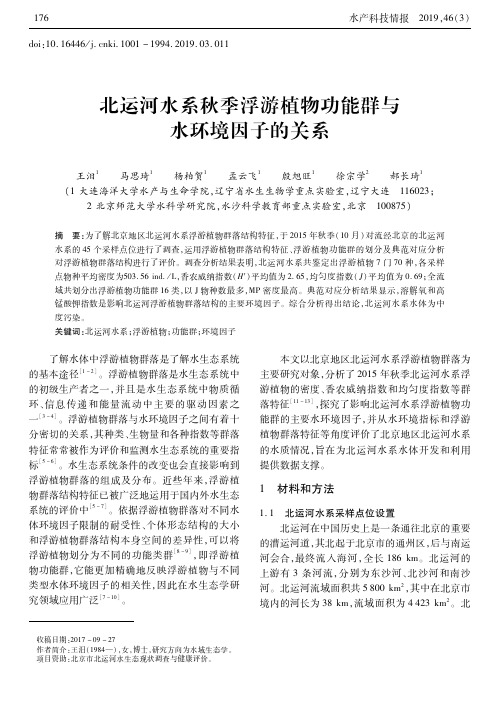
2 结果及分析
图 1 北运河秋季采样点分布
1.2 浮游植物样品的样品采集、鉴定以及水体理 化参数的测定
在北运河水系每个采样点距离水面 1/3水深 处取 2L水样,加入 15mL鲁哥氏液固定,送回实 验室中,静置 24h,将水样浓缩至 100mL,吸取 0.1mL于浮游植物计数框内,在显微镜下进行浮 游植物物种鉴定和细胞的计数工作。浮游植物物 种鉴定参照相关浮游藻类鉴定文献[14-ห้องสมุดไป่ตู้6]进行。
了解水体中浮游植物群落是了解水生态系统 的基本途径[1-2]。浮游植物群落是水生态系统中 的初级生产者之一,并且是水生态系统中物质循 环、信 息 传 递 和 能 量 流 动 中 主 要 的 驱 动 因 素 之 一[3-4]。浮游植物群落与水环境因子之间有着十 分密切的关系,其种类、生物量和各种指数等群落 特征常常被作为评价和监测水生态系统的重要指 标[5-6]。水生态系统条件的改变也会直接影响到 浮游植物群落的组成及分布。近些年来,浮游植 物群落结构特征已被广泛地运用于国内外水生态 系统的评价中[5-7]。依据浮游植物群落对不同水 体环境因子限制的耐受性、个体形态结构的大小 和浮游植物群落结构本身空间的差异性,可以将 浮游植物划 分 为 不 同 的 功 能 类 群 [8-9],即 浮 游 植 物功能群,它能更加精确地反映浮游植物与不同 类型水体环境因子的相关性,因此在水生态学研 究领域应用广泛[7-10]。
在北运河每一个采样点位用水质分析仪现场 测定水温(Temp)、溶解氧(DO)和 pH。采集 2L 定量水样,低温保存,48h内送回实验室,在实验 室中 测 定 叶 绿 素 含 量 (Chl)、高 锰 酸 盐 指 数 (CODMn)、总磷 (TP)、氨 氮 (NH3 -N)以 及 总 氮 (TN)[17]。 1.3 数据的分析和处理
北京北运河水系水质污染特征及污染来源分析

北京北运河水系水质污染特征及污染来源分析北京北运河水系水质污染特征及污染来源分析近年来,随着城市化进程的加速,北京北运河水系面临着严重的水质污染问题。
本文将从水质污染的特征和污染来源两个方面进行分析。
一、水质污染的特征1.化学污染物浓度超标通过对北运河水样的监测,发现其中多种化学污染物的浓度超过了国家标准,例如重金属、农药残留等。
这些化学污染物的存在不仅会对水生生物造成直接的伤害,还可能通过食物链进一步影响人类健康。
2.富营养化北运河水系水域周边的农田、城市排污口等源头排放的养分,使水体中的氮、磷等富营养化物质浓度升高。
这导致水体中的藻类和水草等植物大量繁殖,形成蓝藻水华和水生植被堆积。
这些富营养化现象不仅破坏了水体生态平衡,还使水体的水质变差。
3.微生物污染北运河水系水体还存在大肠菌群等微生物的污染现象。
这些微生物的存在表明水体受到了来自农田、畜禽养殖场等农业活动的污染。
大肠菌群的存在使得水体中潜在的病原微生物的风险增加,对人体健康构成潜在威胁。
二、污染来源分析1.农业活动排放农田中使用的化肥和农药成分,在降雨的冲洗下,沿着农田坡面流入北运河水系水中。
这些化肥和农药的排放量及浓度高低直接关系到水质的好坏。
此外,农田中畜禽养殖场排放的大量养分和粪便也是水质污染的重要来源之一。
2.城市污水排放城市中的污水、工业废水和生活垃圾直接或间接地进入北运河水系,造成水体富营养化、化学污染等问题。
尤其是城市化进程加快后,城市面积增大,污水排放量也相应增加,给水质污染带来了更大的压力。
3.自然因素北运河水系水质污染问题还与自然因素相关。
如一些陡坡、山地、裸露土壤等容易出现水土流失,导致大量的泥沙和养分进入水系。
同时,长时间的干旱或降雨不均也会对水体的水质造成一定的影响。
三、污染治理对策为了改善北运河水系的水质,应采取以下措施:1.强化农业面源污染治理,推广科学耕作和生态农业,减少化肥、农药的使用量。
加强农业废弃物的资源化利用,减少农业活动对水体的污染。
脱氮中微生物的作用

脱氮中微生物的作用脱氮中微生物是指一类具有脱氮能力的微生物,它们主要通过氮素代谢途径,将有机物中的氮转化为气态氮,使之从生态系统中释放。
脱氮中微生物的作用对于生态系统的健康和可持续性有着重要的影响。
以下是脱氮中微生物的作用。
1. 氮素循环:脱氮微生物能够将有机物中的氮(尤其是蛋白质和核酸)转化为氨和硝化物,并最终通过反硝化作用将硝酸根还原为氮气。
这个过程被称为氮素循环,它是地球氮素循环的重要组成部分。
脱氮中微生物通过这个过程控制着土壤中氮素的矿化和固定,将生态系统中的氮素维持在一个平衡状态。
2. 减少重金属的污染:脱氮中微生物能够通过选择性吸附和生物转化来减少重金属的污染。
这些微生物在土壤和水体环境中吸附重金属离子,并利用它们作为能源和电子受体进行代谢。
通过这个代谢过程,重金属离子被转化为无害的沉淀物或氧化物。
3. 控制温室气体的排放:脱氮中微生物能够通过减少氧气的供应,降低土壤中微生物呼吸的速率,从而减少温室气体的排放。
这些微生物能够将有机物中的碳转化为二氧化碳和氮气,从而减少了温室气体的排放量。
4. 降低土地沙化的速度:脱氮中微生物能够通过增加土壤有机质水平来防止土地沙化。
这些微生物通过代谢作用,在土壤中形成有机质,并提供一个良好的土壤微生物群落环境。
这个过程有助于改善土壤的结构和保持水分,并减缓了土地沙化的速度。
5. 保持土壤健康:脱氮中微生物能够通过与土壤中其他微生物相互作用来维护土壤的生态平衡。
这些微生物能够产生一系列有益物质,包括酶、激素和其他代谢产物,有助于保持土壤健康和农作物生长。
总之,脱氮中微生物在地球生态系统中发挥着重要的作用。
通过这些微生物的高效作用,我们可以减少温室气体的排放、减缓土地沙化的速度、减小环境污染以及维持生态系统的平衡和稳定。
因此,对脱氮中微生物的研究和保护对于实现生态环境可持续发展具有重大意义。
工业废水处理中微生物群落结构与脱氮性能关联机制

工业废水处理中微生物群落结构与脱氮性能关联机制工业废水是由工业生产过程中产生的废水,含有大量有机污染物和氮、磷等营养物质,如果直接排入水体中,会对环境造成严重的污染。
因此,对工业废水进行处理是保护环境、维护生态系统的重要措施之一。
而在工业废水处理过程中,微生物群落结构与脱氮性能之间存在着紧密的关联机制。
微生物是自然界中广泛存在的生物类群,在废水处理过程中发挥着重要的作用。
首先,微生物通过降解有机物来消除污染物。
工业废水中的有机污染物可以作为微生物的营养源,微生物能够分解有机物并将其转化为无害的物质。
此外,微生物还能够降解废水中的重金属离子等其他有害物质,从而减少对环境的污染。
其次,微生物在脱氮过程中起到关键作用。
废水中含有大量的氮源,其中主要是氨氮和硝酸盐氮。
脱氮是指将废水中的氮源转化为氮气排放到大气中,从而实现氮的去除。
在工业废水中,微生物通过硝化和反硝化过程来完成脱氮的任务。
硝化是指将氨氮氧化为硝酸盐氮的过程,而反硝化则是将硝酸盐氮还原为氮气的过程。
这两个过程都需要特定的微生物参与,微生物群落的结构和种类的不同将直接影响脱氮的效果。
微生物群落结构的影响因素主要包括环境条件、废水特性和处理工艺等。
不同的废水来源和成分会在一定程度上决定微生物群落的组成和结构。
而废水处理工艺的选择也会对微生物群落产生影响。
例如,活性污泥法是一种常用的废水处理技术,它通过悬浮的污泥颗粒来降解有机物和脱氮。
在活性污泥系统中,不同的微生物群落能够在不同的环境条件下生存和繁殖,通过相互协作来完成脱氮等任务。
此外,微生物的代谢特性和相互关系也会影响脱氮性能。
微生物群落中的不同种类的微生物有不同的代谢特性,有些微生物更擅长氨氮的氧化,有些微生物则更适应于反硝化过程。
微生物之间的相互关系也会影响脱氮性能。
例如,一些微生物能够产生一种类似抑制剂的物质,抑制其他微生物的生长和代谢,从而影响脱氮效果。
因此,在工业废水处理中,要实现高效的脱氮,必须深入了解微生物群落结构与脱氮性能之间的关联机制,并根据这些机制进行相应的调控。
四年级上册英语说课稿-Module 4 Unit 1 Chinese people invented
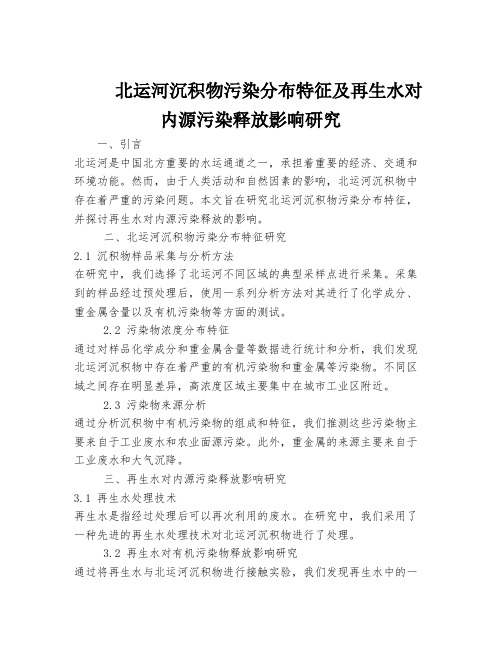
北运河沉积物污染分布特征及再生水对内源污染释放影响研究一、引言北运河是中国北方重要的水运通道之一,承担着重要的经济、交通和环境功能。
然而,由于人类活动和自然因素的影响,北运河沉积物中存在着严重的污染问题。
本文旨在研究北运河沉积物污染分布特征,并探讨再生水对内源污染释放的影响。
二、北运河沉积物污染分布特征研究2.1 沉积物样品采集与分析方法在研究中,我们选择了北运河不同区域的典型采样点进行采集。
采集到的样品经过预处理后,使用一系列分析方法对其进行了化学成分、重金属含量以及有机污染物等方面的测试。
2.2 污染物浓度分布特征通过对样品化学成分和重金属含量等数据进行统计和分析,我们发现北运河沉积物中存在着严重的有机污染物和重金属等污染物。
不同区域之间存在明显差异,高浓度区域主要集中在城市工业区附近。
2.3 污染物来源分析通过分析沉积物中有机污染物的组成和特征,我们推测这些污染物主要来自于工业废水和农业面源污染。
此外,重金属的来源主要来自于工业废水和大气沉降。
三、再生水对内源污染释放影响研究3.1 再生水处理技术再生水是指经过处理后可以再次利用的废水。
在研究中,我们采用了一种先进的再生水处理技术对北运河沉积物进行了处理。
3.2 再生水对有机污染物释放影响研究通过将再生水与北运河沉积物进行接触实验,我们发现再生水中的一些成分可以与有机污染物发生化学反应,降低其在沉积物中的浓度。
这表明再生水可以在一定程度上影响内源有机污染物的释放。
3.3 再生水对重金属释放影响研究类似地,我们还进行了实验研究来探讨再生水对重金属释放的影响。
实验结果表明,在一定条件下,再生水可以与重金属形成络合物,减少其在沉积物中的迁移和释放。
四、结论与展望通过对北运河沉积物污染分布特征及再生水对内源污染释放影响的研究,我们得出以下结论:首先,北运河沉积物中存在着严重的有机污染物和重金属等内源污染物。
其次,不同区域之间存在明显差异,高浓度区域主要集中在城市工业区附近。
北运河沉积物中氨氧化微生物的群落特征
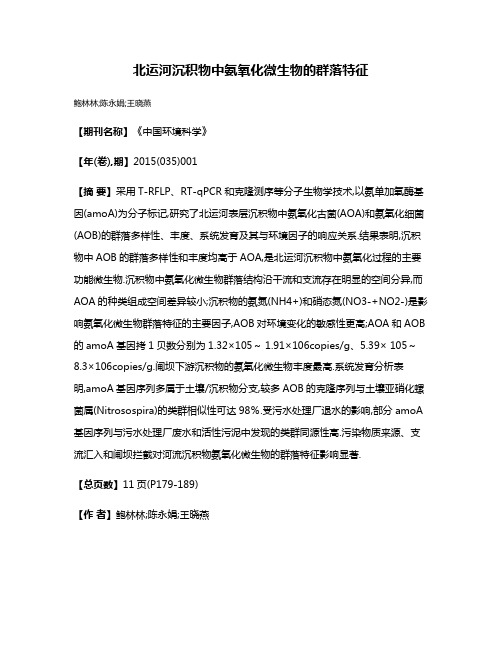
北运河沉积物中氨氧化微生物的群落特征鲍林林;陈永娟;王晓燕【期刊名称】《中国环境科学》【年(卷),期】2015(035)001【摘要】采用T-RFLP、RT-qPCR和克隆测序等分子生物学技术,以氨单加氧酶基因(amoA)为分子标记,研究了北运河表层沉积物中氨氧化古菌(AOA)和氨氧化细菌(AOB)的群落多样性、丰度、系统发育及其与环境因子的响应关系.结果表明,沉积物中AOB的群落多样性和丰度均高于AOA,是北运河沉积物中氨氧化过程的主要功能微生物.沉积物中氨氧化微生物群落结构沿干流和支流存在明显的空间分异,而AOA的种类组成空间差异较小;沉积物的氨氮(NH4+)和硝态氮(NO3-+NO2-)是影响氨氧化微生物群落特征的主要因子,AOB对环境变化的敏感性更高;AOA和AOB 的amoA基因拷1贝数分别为1.32×105~1.91×106copies/g、5.39× 105~8.3×106copies/g.闸坝下游沉积物的氨氧化微生物丰度最高.系统发育分析表明,amoA基因序列多属于土壤/沉积物分支,较多AOB的克隆序列与土壤亚硝化螺菌属(Nitrosospira)的类群相似性可达98%.受污水处理厂退水的影响,部分amoA 基因序列与污水处理厂废水和活性污泥中发现的类群同源性高.污染物质来源、支流汇入和闸坝拦截对河流沉积物氨氧化微生物的群落特征影响显著.【总页数】11页(P179-189)【作者】鲍林林;陈永娟;王晓燕【作者单位】首都师范大学资源环境与旅游学院,北京100048;首都师范大学资源环境与旅游学院,北京100048;首都师范大学资源环境与旅游学院,北京100048;首都师范大学首都圈水环境研究中心,北京100048【正文语种】中文【中图分类】X172【相关文献】1.北运河沉积物中主要脱氮功能微生物的群落特征 [J], 鲍林林;王晓燕;陈永娟;张苓荣2.湛江湾沉积物中氨氧化微生物的丰度、多样性和分布特征 [J], 阳雯娜;董宏坡;侯庆华;李雁群;陈法锦;周欣;毛铁墙3.小型浅水湖泊表层沉积物氨氧化古菌群落结构特征 [J], 燕文明;刘凌;赵倩维;杨艳青4.翅碱蓬对盐沼沉积物微生物生物量及β-氨氧化细菌群落的影响——以双台河口为例 [J], 刘姣;刘长发;李盛德;李晋;陶韦;李璐瑶;马悦欣5.高原湖泊沉积物中反硝化微生物的群落特征——以包头南海湖为例 [J], 杨文焕; 石大钧; 张元; 李卫平; 敬双怡; 于玲红因版权原因,仅展示原文概要,查看原文内容请购买。
红树林湿地中脱氮微生物脱氮特性及其种群结构分析

红树林湿地中脱氮微生物脱氮特性及其种群结构分析林娜摘要随着沿岸水体氮素富营养化的加剧,生物脱氮作用越来越受重视,位于海陆交界的湿地红树林生态系统作为一个自然脱氮体系备受关注。
本研究以典型亚热带湿地红树林(香港Mai Po)作为对象,结合传统的富集筛选和分子生物学方法对红树林沉积物中硝化、反硝化细菌脱氮能力、种群结构和丰度进行研究。
从Mai Po红树林中筛选到7株异养硝化菌,分别属于Diaphorobacter sp., Paracoccus sp., Ochrobactrum sp., Sinorhizobium sp., Pseudomonas sp和Hydrogenophaga sp.;有6株异养硝化菌2天内NH4+-N去除率就达到80%以上,另外那株细菌NWTT2天内NH4+-N去除率为40.80%,第3天NH4+-N去除率达到96.65%;菌株NYMO和NYTE具有同时硝化反硝化作用的能力,具体地,菌株NYMO和NYTE2d内NH4+-N去除率为34.60%和35.08%,NO3--N去除率为33.40%和99.92%。
从Mai Po红树林中筛选到12株好氧反硝化菌和8株厌氧反硝化菌,分别属于Comamonas、Pseudomonas、Thauera、Agrobacterium、Acinetobacter、Ochrobactrum、Hydrogenophaga、Alcaligenes和Unculturedβ—proteobacterium,优势菌属为Pseudomonas菌属;其中7株好氧反硝化菌和8株厌氧反硝化菌在2天内N03--N去除率达到98%;测定氧气对好氧反硝化菌株HWTT的N20逸出量影响的实验结果表明:氧气不足条件下,N20逸出量最高值为0.15μmol, N2O/(N2O+N2)低于0.15%;好氧条件下,N20逸出量为35.71μmol, N2O/(N2O+N2)为70%以上。
北京六湖水体和表层沉积物中氮污染特征与评价
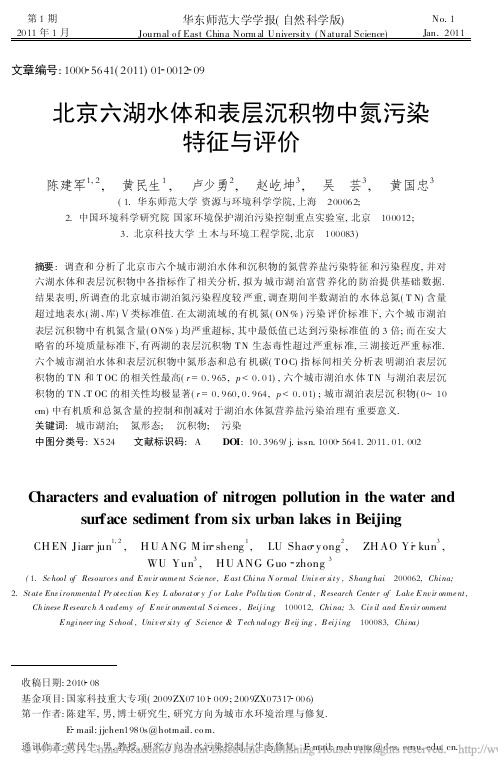
第1期2011年1月华东师范大学学报(自然科学版)Journal of East China Norm al University (Natural Science)No.1 Jan.2011文章编号:1000 5641(2011)01 0012 09北京六湖水体和表层沉积物中氮污染特征与评价陈建军1,2, 黄民生1, 卢少勇2, 赵屹坤3, 吴 芸3, 黄国忠3(1.华东师范大学资源与环境科学学院,上海 200062;2.中国环境科学研究院国家环境保护湖泊污染控制重点实验室,北京 100012;3.北京科技大学土木与环境工程学院,北京 100083)摘要:调查和分析了北京市六个城市湖泊水体和沉积物的氮营养盐污染特征和污染程度,并对六湖水体和表层沉积物中各指标作了相关分析,拟为城市湖泊富营养化的防治提供基础数据.结果表明,所调查的北京城市湖泊氮污染程度较严重,调查期间半数湖泊的水体总氮(T N)含量超过地表水(湖、库) 类标准值.在太湖流域的有机氮(ON %)污染评价标准下,六个城市湖泊表层沉积物中有机氮含量(O N%)均严重超标,其中最低值已达到污染标准值的3倍;而在安大略省的环境质量标准下,有两湖的表层沉积物T N 生态毒性超过严重标准,三湖接近严重标准.六个城市湖泊水体和表层沉积物中氮形态和总有机碳(T O C)指标间相关分析表明湖泊表层沉积物的T N 和T OC 的相关性最高(r =0.965,p <0.01),六个城市湖泊水体T N 与湖泊表层沉积物的T N 、T OC 的相关性均极显著(r =0.960,0.964,p <0.01);城市湖泊表层沉积物(0~10cm)中有机质和总氮含量的控制和削减对于湖泊水体氮营养盐污染治理有重要意义.关键词:城市湖泊; 氮形态; 沉积物; 污染中图分类号:X 524 文献标识码:A DOI :10.3969/j.issn.1000 5641.2011.01.002收稿日期:2010 08基金项目:国家科技重大专项(2009ZX 07101 009;2009ZX 07317 006)第一作者:陈建军,男,博士研究生,研究方向为城市水环境治理与修复.E mail:jjchen 1980s @hotmail.co m.通讯作者:黄民生,男,教授,研究方向为水污染控制与生态修复.E mail:mshuang @.C haracters and evaluation of nitrogen pollution in the water andsurface sediment from six urban lakes in BeijingCH EN Jian jun 1,2, H U ANG M in sheng 1, LU Shao y ong 2, ZH AO Yi kun 3,WU Yun 3, H U ANG Guo zhong 3(1.Sc hool of Resource s and E nv ir onme nt S cie nce ,E ast China N ormal Univ er sity ,S hang hai 200062,China;2.State Env ironmenta l Pr otec tion K ey L aborator y f or L ake Pollu tion Contr ol ,R esearch Cente r of L ake E nv ir onme nt,Ch inese R esearc h A cad emy of E nv ir onmental S ciences ,Beij ing 100012,China;3.Civ il and En vir onmentE ngineer ing S chool ,Univ er sity of S cience &T ech nology B eij ing ,B eij ing 100083,China)13第1期华东师范大学学报(自然科学版)Abstract: T he pollution characters,deg ree and cor relations of the index es in water and sur facesediments from six lakes in Beijing wer e investig ated to pro vide data for the eutro phication contr ol of ur ban lakes.Results show ed that nitro gen po llut ion of these urban lakes was ser io us,andthe w ater to tal nit rog en(T N)of thr ee lakes w ere a ll wo rse than t hat of N ational Envir onmentQuality Standa rd for Surface W ater Gr ade V during t he investig atio n perio d.Accor ding t o theT aihu Lake Basin Po llut ion Standard,the or ganic nitro gen co nt ent(ON%)pollutio n fr om thesurface sediment o f the six lakes wer e v ery ser ious:the minimum fr om w hich w as three times ofthe pollutio n standard level.A cco rding to the standard o f Canada,the eco lo gical t ox ic o f sediments T N fro m two lakes wer e bo th above ser io us to x icity standards,while that o f o ther thr eelakes w ere all near to t he serio us tox icity standards.T he cor relat ion of nitro gen fractio ns andT OC content bet ween index of water and sur face sediment fro m the six ur ban lakes w ere calculated,and t he results sho wed that the co rr elation betw een sediment T N and sediment T OC was thehighest(r=0.965,p<0.01),co rr elatio ns betw een w ater T N and sediment T N and T O C w asex tr emely signif icant(p<0.01)as0.960,0.964,respectiv ely.T he investigation sugg ested t hatthe contr ol and reduction of T O C and T N in surface sediment(0~10cm)of ur ban lake ar e ofimportant sig nificance to the co nt rol of nitr og en pollutio n in t he lake w ater.Key words: ur ban lakes; nit rog en fr actions; sediment; pollutio n0 引 言城市湖泊是位于城区及其近郊的中小型湖泊,大多数城市湖泊融合了当地人文景观和自然景观,是城市的重要休闲地和经济发展的资源.近年来,尽管多数城市已严格控制向城市湖泊的点源污染排放,但是城市化造成的非点源污染入湖仍很严重[1].另外,城市湖泊多为静止或缓流的浅水水体,具有水域面积和水环境容量小,水体自净能力低的特点.以上种种因素导致了我国众多的城市湖泊已达富营养化和重富营养化程度,如杭州西湖、武汉墨水湖、南京玄武湖和广州流花湖等[2,3].相比太湖和滇池等大型天然湖泊,城市湖泊的研究基础显得相对薄弱;且由于所处的地理位置和功能定位不同,使得城市湖泊水体的演变过程和污染状况与天然湖泊相比有较大差异.因此,对城市湖泊开展深入系统的研究工作显得日益迫切.目前,已开展不少关于城市湖泊水体富营养化状况调查[4,5]以及城市湖泊沉积物污染状况[6,7]的研究工作,但鲜见对于城市湖泊水体和沉积物中营养盐赋存关系的系统研究报道.氮在水生生态中具重要作用,不仅是湖泊富营养化的主要营养元素,而且往往是湖泊水质最主要的污染物[8 10].本研究对北京市区6个城市湖泊开展了湖泊水体和表层沉积物(0~10cm)的氮营养盐污染调查,对其城市湖泊的氮营养盐污染特征及程度进行了初步分析和评价,拟为城市湖泊的富营养化的防治工作提供基础数据和决策依据.1 调查采样与样品处理1.1 采样点位的选取本研究的采样工作从2010年4月21日开始,至4月29日结束,采样时间定在每天上午10:00左右.期间对北京市区6个不同富营养化程度的湖泊,包括前海(QH)、青年湖14陈建军,等:北京六湖水体和表层沉积物中氮污染特征与评价2011年(QN)、昆明湖(KM)、紫竹院湖(ZZ)、陶然亭湖(TR)和红领巾湖(H LJ)的水体和湖泊表层沉积物开展了调查分析.六个采样湖泊的选取主要考虑两个因素.(1)湖泊富营养化程度 以2006年北京市环境保护监测中心对城区21个重点湖泊的水质监测数据为依据[4],分别选取营养状态级别为水质轻度富营养(QH,KM)、中度富营养(QN,ZZ)和重度富营养(T R, H LJ)的湖泊各两个.(2)地理位置 采样的湖泊点位在北京城区东南西北4个方位均匀分布,以便较全面地考察北京城市湖泊的污染状况.每个采样湖泊均匀设置3个采样点,租用游船采集水和沉积物样品.1.2 样品采集与前处理水样在每个样点在距水面0.5m深处采集,采集后立即装入300mL聚乙烯采样瓶中.采样现场测定的水质理化指标包括水温()、pH、溶解氧(DO)等.具体监测数据结果参见表1.每样点用小号的彼得森采泥器(尺寸20cm!30cm!60cm,重量5.5kg)采集湖泊表层(约0~10cm)的沉积物样品,采集后装入聚乙烯袋密封并避光保存.野外现场采样时间约1.5~2h,完毕后迅速返回实验室,当天测定水样的理化指标;沉积物样迅速放冰柜冷冻24h后再放入冷冻干燥机低温干燥,干燥一周后取出样品逐个使用玛瑙研钵研磨并过100目筛备用.表1 六湖概况及部分水质指标数据T ab.1 T he general situation and indexes of water from t he six lakes湖泊名面积/km2水深/m水温/pH DO/(mg∀L-1)经度(E)纬度(N)QH0.31.313.69.215.6116#23∃0.66%39#56∃18.91% QN0.051.614.68.812.1116#22∃50.52"39#57∃13.17% KM1.941.116.38.812.3116#15∃58.0%39#57∃13.17% ZZ0.161.815.78.811.8116#18∃39.54%39#56∃2.35% TR0.171.414.59.614.8116#22∃40.2%39#52∃25.4% HLJ0.161.514.810.011.7116#29∃13.01%39#55∃33%注:水深、水温、pH和DO均为各湖内为3个样点的均值1.3 样品提取与分析水温、pH和DO采用便携式多参数水质分析仪(SensionTM156,H ACH Co mpany, USA)现场测定,湖泊水体中总氮(T N)的测定采用过硫酸钾氧化 紫外分光光度法,氨氮(NH3 N)测定采用纳氏试剂光度法,硝酸盐氮(NO-3 N)测定采用紫外分光光度法,水体中总有机碳(TOC)采用岛津TOC分析仪测定.沉积物T N及T OC含量测定采用元素分析仪(Vario M ACRO,Germ an)分析测定,具体步骤如下[11]:每个样品称取两份,各0.2g左右,一份先经1mo l/L盐酸浸泡12h去除无机碳,去离子水洗净离心3次,40以下低温烘干后用于测定T OC含量;另一份样品直接用于元素分析测定T N含量.元素分析时,称取上述处理后的样品各30mg左右加催化剂,一起用锡纸包好后分别放入仪器中测量.沉积物样中NH3 N含量测定方法为:称取冷冻干燥后的沉积物干样3g,加2m ol/L的KCl溶液振荡提取30min(固液比1&10),1000r/min离心后取上清液用纳氏试剂光度法测定[12].沉积物样中NO-3 N含量测定方法为:称取冷冻干燥后的沉积物干样3g,加饱和硫酸钙溶液振荡提取15m in(固液比1&10),1000r/min离心后取上清液用紫外分光光度法测定[12].2 结果与讨论2.1 六湖水体中氮形态含量比较分析第1期华东师范大学学报(自然科学版)测定水中各种形态的氮化合物,有助于评价水体被污染程度和∋自净(的程度.反映水体受含氮化合物污染程度的几种主要形态的氮是T N,NH 3 N 和N O -3 N,在天然水体NO -2 N 浓度很低,并且极易转化成NO 3 N [13],故未作测定.6个采样湖泊的3种氮形态的比较参见图1.六湖中,KM,H LJ,QH 三湖的T N 含量相对较低,分别为1.43,1.68,1.75mg /L,为地表水环境质量标准(湖、库)的)类∗+类标准;ZZ 和QN 两湖T N 含量相对较高,分别为2.92和4.15m g/L,T R 的TN 含量最高,为10.3mg/L,该三湖的总氮水平均超过湖库水的 类标准.图1 六湖水体T N ,N H 3 N 和N O 3 N 含量F ig.1 Content of T N,N H 3 N and N O 3 N fr om wat er of the six lakes6个湖泊中,QN 的NH 3 N 浓度相对最高,为2.93mg /L,严重超过NH 3 N 的地表水 类标准;其他5个湖的NH 3 N 含量较为接近,在0.15~0.43mg /L 之间,达到地表水,类标准.除QN 和H LJ 以外,其他4个湖泊水体中硝酸盐氮为湖泊水体氮的主要形式,硝酸盐氮占总氮含量的75%~84%,且该四湖水体硝酸盐氮的变化规律和总氮一致(见图2).QN 的T N 和NH 3 N 含量均很高,而NO 3 N 则很低.另参见表1数据可知QN 的溶解氧处于很高水平,因此该湖中硝化作用很弱,可能是硝化细菌很少或活性受到了抑制.由于在天然水体NO -2 N 浓度很低[13],湖水中的有机氮(ON )含量通过总氮与氨氮、硝氮的差值计算出;H LJ 的NH 3 N 和NO 3 N 含量均相对较低,ON 含量最高,达到50%,而其他四湖水体的ON 含量均低于20%.2.2 六湖表层沉积物中氮形态及含量比较分析对图2数据分析比较可知,6个城市湖泊中表层沉积物的TN,NH 3 N 和NO 3 N 含量差异均非常明显.对于表层沉积物的T N 而言,六湖中TR 的T N 含量最高,达到13348mg /kg;而KM 中TN 含量最低,仅为3140mg/kg.对于NH 3 N 而言,六湖中QN 和TR 的NH 3 N 含量相对较高,均达到80mg/kg ,QN 的各点位差异较大,其中最高点NH 3 N 含量达到140mg/kg ;其他几个湖的NH 3 N 含量差异不大,变化范围在20~60mg/kg.对于NO 3 N 而言,在H LJ 表层沉积物中含量最高,均值为42mg/kg ;ZZ 最低,均值为3.0mg/kg ,且湖内各点位间的差异很小.在6个城市湖泊中,表层沉积物的NH 3 N 占T N 的比例较低,约为0.5%~1.5%,NH 3 N 占T N 的比例约为0.1%~1%,表明六城市湖泊表层沉积物中的TN 主要是以ON 的形态存在.15陈建军,等:北京六湖水体和表层沉积物中氮污染特征与评价2011年图2 六湖表层沉积物T N,N H 3 N 和N O 3 N 含量Fig.2 Contents o f T N ,N H 3 N and NO 3 N fr om surface sediment of six lakes2.3 六湖水体和表层沉积物中T OC 含量比较分析对六湖水体中T OC 含量的分析表明(见图3),H LJ 的TOC 含量最高,约为16m g/L;其次是TR 和QN,约为12~14mg /L,其他三湖水体中的T OC 含量差异不大,为8~9m g/L 左右.六湖表层沉积物中的T OC 含量较高,占沉积物干重的3%~17%,对于不同的湖泊而言,TR 的表层沉积物中T OC 含量最高且远高于其它湖泊,约为173mg/g,H LJ 的T OC 含量最低,为35mg /g;其他四湖的表层沉积物T OC 含量差别不大,变化范围在45~65mg/g 之间.根据沉积物中有机质和TOC 换算关系经验公式,可以估算出北京六湖表层沉积物的有机质含量为干重的5%~28%,是一个潜在的大量营养源.图3 六湖水体和表层沉积物中T O C 含量Fig.3 Contents o f T OC fr om w ater and surface sediment of six lakes2.4 水体和表层沉积物中指标间的相关分析将图1和图2进行比较分析可以观察到不同城市湖泊的氮营养盐在湖泊上覆水和表层沉积物之间的变化规律较为类似.现采用SPSS 16.0软件对6个湖泊水体和表层沉积物中的氮形态及水体叶绿素指标之间进行Pearso n 相关分析(2 tailed),其结果参见表2. 对6个城市湖泊水体和表层沉积物中的TN,NH 3 N ,NO 3 N 和T OC 4个指标两两之间进行相关分析,相关关系矩阵数据表明:水体TN 和表层沉积物T N 相关极显著,r =1617第1期华东师范大学学报(自然科学版)0.960(p<0.01);水体的NO3 N和水体T N以及沉积物T N的相关性也很高,其相关系数均分别为r=0.893,0.836(p<0.01).另外,水体的N H3 N和沉积物NH3 N相关系数r=0.805(p<0.01),沉积物T N和沉积物NH3 N之间的相关达到显著水平r=0.519 (p<0.05);其他各指标之间的相关关系均未达到显著水平.表2六湖水体和表层沉积物指标间相关矩阵T ab.2 Co rrelatio n matr ix of indexes fr om wat er and surface sediment in the six lakes T N(S) NH3 N(S) NO3 N(S) T OC(S)TN(W)NH3 N(W)NO3 N(W)TOC(W) TN(S)1NH3 N(S)0.519*1NO3 N(S)0.4450.1061T OC(S)0.965**0.4040.3021T N(W)0.960**0.4410.3600.942**1NH3 N(W)0.2200.805**0.0360.7970.1831NO3 N(W)0.836**0.1020.2670.902**0.893**-0.2391TOC(W)0.3580.2110.823**0.4760.3830.2260.2171注:(S)表示六湖表层沉积物的指标,(W)表示水体的指标;*表示相关系数达0.05的显著水平,**表示相关系数达0.01的显著水平不同城市湖泊的水体和表层沉积物之间的TN和NH3 N相关性均达到了极显著水平,说明水体和表层沉积物之间有强烈的氮营养盐交换,而且可能是沉积物中的TN以NH3 N的形式向上覆水体释放;然后上覆水体NH3 N在城市浅水湖泊水体的好氧状况以及微生物的作用下硝化成N O3 N,这可能是水体的NO3 N和水体T N较高的相关性(见表2)以及四个湖泊水体中硝酸盐氮为湖泊水体氮的主要形式(占总氮的含量为75%~84%,见图1)的原因.表层沉积物中的T OC与TN相关性最高(r=0.965,p<0.01),但与沉积物中的NH3 N和NO3 N的相关关系均不显著,表层沉积物中的TOC与水体T N和NO3 N的相关关系均达到极显著水平;水体中的TOC与沉积物中的硝氮相关性极显著(r= 0.823,p<0.01),但与水体和表层沉积物中的其他指标相关性均不显著(见表2).综合以上分析,6个北京城市湖泊湖泊表层沉积物的T N和T OC的相关性最高(r= 0.965,p<0.01),另六湖水体TN与湖泊表层沉积物的TN、T OC的相关性均极显著(r= 0.960、0.964,p<0.01).这说明城市湖泊湖泊表层沉积物的T N主要来源于有机质,城市湖泊水体T N含量与湖泊表层沉积物总氮含量有较好对应关系;这可能是因为城市湖泊水体较为封闭、水体流态缓慢而导致水体和沉积物之间的氮营养盐交换非常明显.因此,对于城市湖泊水体氮营养盐的控制和削减,应重点考虑对湖泊表层沉积物有机质和氮营养盐污染的治理.2.5 六湖表层沉积物污染评价2.5.1 表层沉积物营养评价有机指数通常作为水域沉积物环境状况的指标:有机指数=有机碳(%)!有机氮(%);其中,有机氮=总氮!0.95.有机氮是常用来衡量湖泊表层沉积物有否遭受氮污染的重要指标,参照太湖流域相关文献资料[14,15],有机指数和有机氮的评价标准见表3.陈建军,等:北京六湖水体和表层沉积物中氮污染特征与评价2011年表3 有机指数和有机氮评价标准T ab.3 Evaluatio n cr iter ion of o rg anic index and ON%类型与等级有机指数有机氮含量/%类型与等级有机指数有机氮含量/%清洁/−<0.05<0.033尚清洁/)0.20~0.500.066~0.133较清洁/,0.05~0.200.033~0.066污染/+>0.05>0.133本研究中,六城市湖泊的各采样点的表层沉积物中有机碳含量(TOC%)、氮含量(N%)采用元素分析仪(Vario MACRO,German)分析测定,有机氮含量(ON%)根据经验公式:有机氮=总氮!0.95换算得出.具体数据见表4所示.表4 六湖表层沉积物TOC%,N%,ON%和有机指数T ab.4 T OC%,N%,O N%and o rg anic index of surface sediment fro m the six lakes 湖泊名称T OC%N%ON%有机指数QH6.600.4790.4553.00QN7.320.6890.6544.79KM4.570.3140.2981.36ZZ5.960.4310.4092.44TR17.31.040.98817.1H LJ3.500.4080.3881.36注:表中数据均为每湖中各样点的均值依据表3的标准,对照表4的数据可知六城市湖泊的表层沉积物有机指数和ON%均超过了∋污染/+(等级:有机污染指数最高的湖是TR,超过污染标准数十倍;QN,QH,ZZ 三湖的沉积物的有机污染相对较高,有机污染最轻的湖是KM和H LJ,均为污染标准的3倍左右.六湖表层沉积物的ON%亦均超标,且变化规律与有机指数较为类似,但不同湖泊ON%的超标倍数多数比有机指数要低.2.5.2 氮营养盐对底栖生物的生态毒性评价表层沉积物质量对底栖生物生存环境有重要影响,若污染物超过某一水平将对底栖生物产生毒性效应.本试验采用加拿大安大略省环境和能源部制定的环境质量标准来对采样的6个城市湖泊的表层沉积物的T OC(%)和T N进行生态毒性效应评价.此标准分为3级:(1)安全级,此时在水生生物中未发现中毒效应;(2)最低级,此时沉积物已受污染,但是多数底栖生物可以承受;(3)严重级,此时底栖生物群落已遭受明显的损害[16].具体调查数据和评价标准见表5.表5 六湖表层沉积物调查数据和对应的生态毒性标准T ab.5 Com par e o f sur face sediment index es and the ecolog ical t ox icity standards调查数据TOC/%TN/(mg∀kg-1)生态性标准评价标准T OC/%总氮/(m g∀kg-1)QH6.604793 QN7.326887 KM4.573140 ZZ5.964308 TR17.313348 H LJ3.504080安全//最低1550严重104800从表5中数据可知,在加拿大安大略省环境和能源部制定的环境质量标准下,6个北京1819第1期华东师范大学学报(自然科学版)城市湖泊表层沉积物中TN的生物毒性水平普遍较高,QN和T R的T N含量均大于4800mg/kg,达到对底栖生物有严重毒性的污染程度,T N最低的KM也已接近严重毒性级别.六湖表层沉积物中TOC(%)的生物毒性也较高,TR的T OC(%)对底栖生物的毒性水平最高且超过了严重级别,其次是QN、QH和ZZ,它们的总TOC(%)也超过了严重毒性水平的一半水平.另在所采集QH,KM沉积物中有螺的白色残体存在,而在T R和QN和表层沉积物中没有发现,这也可以说明污染的湖泊底泥严重影响了底栖生物的生存.3 结 论北京市六个城市湖泊水体及表层沉积物中的氮营养盐污染负荷总体上较严重.调查期间,有一半湖泊的水体TN含量超过地表水(湖、库) 类标准,另3个湖的TN含量在)类∗+类标准之间.在太湖流域的ON%污染评价标准下,6个北京城市湖泊层沉积物的ON%均严重超过了污染级别的标准值,其中最低的ON%值已达到污染标准值的3倍.而在加拿大安大略省环境和能源部制定的环境质量标准下,六湖中有两个湖的T N超过严重生物毒性标准,3个湖的TN接近严重生物毒性标准,T N最低的湖泊也超过了严重毒性标准值的一半.6个城市湖泊的表层沉积物T N,NH3 N和NO3 N含量的差异均非常明显,对6个城市湖泊水体和表层沉积物中氮形态和T OC指标两两之间的进行了相关分析,结果表明:6个北京城市湖泊表层沉积物的TN和TOC的相关性最高(r=0.965,p<0.01),六湖水体TN与湖泊表层沉积物的TN,TOC的相关性均极显著(r=0.960、0.964,p<0.01).城市湖泊水体TN含量与湖泊表层沉积物(0~10cm)总氮含量有较好对应关系,城市湖泊表层沉积物中有机质和总氮含量的控制和削减对于湖泊水体氮营养盐污染的治理有重要意义.[参 考 文 献][1] 杨柳,马克明,郭庆海,等.城市化对水体非点源污染的影响[J].环境科学,2004,25(6):32 39.YANG L,M A K M,GUO Q H,et al.Effects of urbanization on n on point pollution of water environment[J].En viron men t Science,2004,25(6):32 39.[2] 金相灿,刘树坤,章宗涉,等.中国湖泊环境(第二册)[M].北京:海洋出版社,1995.JIN X C,LILI S K,ZH ANG Z S,et al.T he Lake Environment of China(the S econd Volume)[M].Beijing:O cean Publishing H ouse of Ch ina,1995.[3] 彭俊杰,李传红,黄细花.城市湖泊富营养化成因和特征[J].生态科学,2004,23(4):370 373.PENG J J,LI C H,H UANG X H.Caus e and characteristics of eutrophication in urb an lak es[J].Ecology S cien ce, 2004,23(4):370 373.[4] 荆红卫,华蕾,孙成华,等.北京城市湖泊富营养化评价与分析[J].湖泊科学,2008,20(3):357 363.J ING H W,H UA L,SUN C H,et al.Analysis on u rban lak es.eutrophication statu s in Beijin g[J].J ournal of Lake S cien ces,2008,20(3):357 363.[5] 郭晓彬.广东省城市湖泊氮、磷污染特征研究[D].广东:暨南大学,2006.GUO X B.S tudy on the characteristic of nitrogen an d phos phorus pollution of urban lakes in Guangdong pr ovin ce[D].Guangdong:Jinan U nivers ity,2006.[6] 谭镇,钟萍.惠州西湖底泥中氮磷特征的初步研究[J]生态科学,2005,24(4):318 321.T AN Z,ZHONG P.Prelim inary study on the ch aracteristics of nitrogen and phos phorus in the s ediments ofH uizh ou W es t Lake[J].Ecology Science,2005,24(4):318 321.20陈建军,等:北京六湖水体和表层沉积物中氮污染特征与评价2011年[7] 李卫平,李畅游,贾克力,等.内蒙古呼伦湖沉积物营养元素分布及环境污染评价[J].农业环境科学学报,2010,29(2):339 343.LI W P,LI C Y,JIA K L,et al.Distribution of nutrient elem ents and environmental pollu tion as ses sment in s edi ment of Hulun lak e,Inner M ongolia[J].Journ al of Agro Environment S cience,2010,29(2):339 343.[8] 金相灿,屠清瑛.湖泊富营养化调查规范[M].2版.北京:中国环境科学出版社,1990.JIN X C,T U Q Y.Investigation S pecifications of Lakes.Eutrophication[M].2n d ed.Beijing:Chin es e PublishingH ouse of Environment S cien ce,1990.[9] ELS ER J J,M ARZOLF E R,GOLDM AN C R.Phosphoru s and n itr ogen limitation of phytoplankton grow th inthe freshw aters of North America:A review and critique of experimental enrichments[J].Can J Fish Aquat Sci, 1990,47(7):1468 1477.[10] BERM AN T,CH AVA S.Algal growth on organic com pounds as nitrogen sources[J].J ou rnal of Plankton Research,1999,21(8):1423 1437.[11] 于雯泉.胶州湾李村河口区沉积物有机碳、酸可挥发硫化物及重金属的环境响应[D].山东青岛:中国科学院海洋研究所,2006.YU W Q.Environm ental resp on ses of total organic carbon,acid volatile sulfide and h eavy metals in L icun estuar ine s edim ents,Jiaozhou Bay[D].Qin gdao Sh andong:M arin e Resear ch Institute,Chinese Acad emy of Sciences, 2006.[12] 鲍士旦.土壤农化分析[M].北京:中国农业科技出版社,2000.BAO S D.Agro ch emistry Analys is of Soil[M].Beijing:Chin a Publis hing Hous e of Agro science,2000.[13] 卢少勇,金相灿,余刚.人工湿地的磷去除机理[J].生态环境,2006,15(2):391 396.LU S Y,JIN X C,YU G.Phos phorus removal mechan ism of constructed w etland[J].Ecological En vir on ment, 2006,15(2):391 396.[14] 孙顺才,黄漪平.太湖[M].北京:海洋出版社,1993.S UN S C,H UANG Y P.T aihu Lak e[M].Beijing:Ocean Publis hing Hou se of Chin a,1993.[15] 隋桂荣.太湖表层沉积物中OM、T N、T P的现状与评价[J].湖泊科学,1996,8(4):319 324.SUI G R.Statemen t and evaluation of organic matter,total nitrogen and total phos phate in su rface layer sedim ents in T aiH u lake[J].J ou rnal of L ake S ciences,1996,8(4):319 324.[16] M UDROCH A,AZCUE D J M.M anual of Aquatic Sediment Sam pling[M].Boca Raton:Lew is Ph ublications,1995.。
渤海沉积物中氮的形态及其在循环中的作用
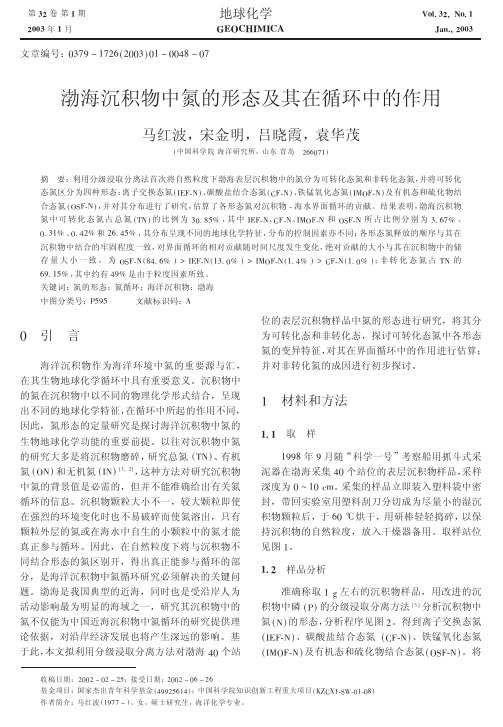
第 $# 卷 第 ! 期 #**$ 年 ! 月
地球化学
+,-./010.2
%&’" $#( )&" ! 345"( #**$
碳酸盐结合态氮 ! -*+, ’ 、 铁锰氧化态氮 ! (./*+, ’ 及有机态和硫化物结 态氮区分为四种形态: 离子交换态氮 ! ()*+, ’ 、 合态氮 ! /0*+, ’ , 并对其分布进行了研究, 估算了各形态氮对沉积物 + 海水界面循环的贡献。结果表明, 渤海沉积物 氮 中 可 转 化 态 氮 占 总 氮 ! 1, ’ 的 比 例 为 2$3 456 , 其 中 ()*+,、 -*+,Байду номын сангаас (./*+, 和 /0*+, 所 占 比 例 分 别 为 23 #%6 、 其分布呈现不同的地球化学特征, 分布的控制因素亦不同; 各形态氮释放的顺序与其在 $3 2&6 、 $3 7"6 和 "#3 756 , 沉积物中结合的牢固程度一致, 对界面循环的相对贡献随时间尺度发生变化, 绝对贡献的大小与其在沉积物中的储 非 转 化 态 氮 占 1, 的 存 量 大 小 一 致 , 为 /0*+, ! 473 #6 ’ 8 ()*+, ! &23 $6 ’ 8 (./*+, ! &3 76 ’ 8 -*+, ! &3 $6 ’ ; 其中约有 796 是由于粒度因素所致。 #93 &56 , 关键词:氮的形态;氮循环;海洋沉积物;渤海 中图分类号::595 文献标识码:;
洱海沉积物中不同形态氮的时空分布特征_赵海超

基金项目: 国家自然科学基金项目( 41173118 ,U1202235 ) ; 国家水体 污染控制与治理科技重大专项( 2012ZX07105 - 005 ) 作者简介: 赵海超( 1974 - ) ,男,内蒙古赤峰人,副教授,博士,主要 从事湖泊生态修复研究,haichaozhao19@ 163. com. * 责任作者, 王圣瑞( 1972 - ) ,男,内蒙古呼和浩特人,研究员,博 士,主要从事水体环境学研究,wangsr@ craes. org. cn
收稿日期: 2012 - 08 - 20 修订日期: 2013 - 01 - 16
of their TN with higher densities in the middle region for SAEFN and in the south region for SOEFN. The seasonal variations of the TN and NTN contents were the highest in the summer ( July) and that of TTN and their different forms were the highest in the spring ( January ) . The content of different nitrogen forms showed a decreasing trend with the sediment depth inc of NTN was higher than that of TN in the surface
236
环
境
科
学
研
究
第 26 卷
sediment. The content of TN in the sediments of Erhai Lake was higher than that in the lakes of the middle and the lower regions of the Yangtze. Meanwhile,the surface enrichment of TN was great. The percentage of TTN and IEFN in the total nitrogen was relatively low, although the releasing risk of nitrogen was high. This, indicated that there was a small amount of the nitrogen released in the sediment of Erhai Lake. The content of different forms of nitrogen showed a significant positive correlation with TOM and a negative correlation with the water depths for the sediments. Moreover,the nitrogen and the organic matter were synchronously precipitated. The exogenous inputs had strong influences on the nitrogen contents,and the distribution of TTN was greatly affected by the activities of aquatic species such as aquatic plants. Key words: Erhai Lake; sediments; the nitrogen forms; temporal and spatial distribution
河口水体中的菌群分析及其脱氮能力的研究
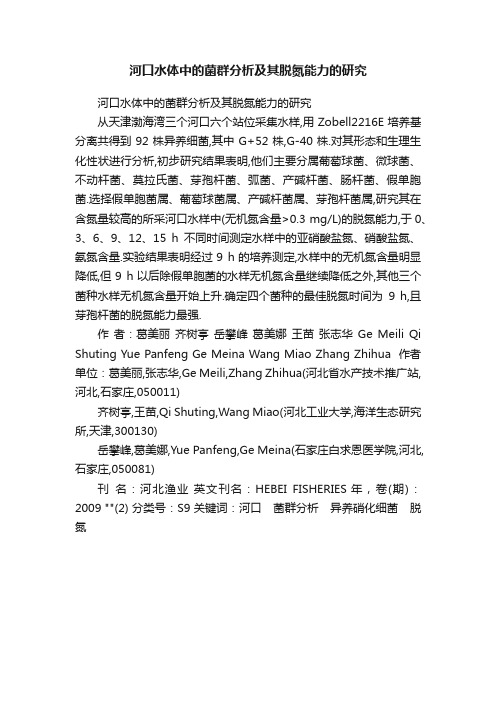
河口水体中的菌群分析及其脱氮能力的研究
河口水体中的菌群分析及其脱氮能力的研究
从天津渤海湾三个河口六个站位采集水样,用Zobell2216E培养基分离共得到92株异养细菌,其中G+52株,G-40株.对其形态和生理生化性状进行分析,初步研究结果表明,他们主要分属葡萄球菌、微球菌、不动杆菌、莫拉氏菌、芽孢杆菌、弧菌、产碱杆菌、肠杆菌、假单胞菌.选择假单胞菌属、葡萄球菌属、产碱杆菌属、芽孢杆菌属,研究其在含氮量较高的所采河口水样中(无机氮含量>0.3 mg/L)的脱氮能力,于0、3、6、9、12、15 h不同时间测定水样中的亚硝酸盐氮、硝酸盐氮、氨氮含量.实验结果表明经过9 h的培养测定,水样中的无机氮含量明显降低,但9 h以后除假单胞菌的水样无机氮含量继续降低之外,其他三个菌种水样无机氮含量开始上升.确定四个菌种的最佳脱氮时间为9 h,且芽孢杆菌的脱氮能力最强.
作者:葛美丽齐树亭岳攀峰葛美娜王苗张志华Ge Meili Qi Shuting Yue Panfeng Ge Meina Wang Miao Zhang Zhihua 作者单位:葛美丽,张志华,Ge Meili,Zhang Zhihua(河北省水产技术推广站,河北,石家庄,050011)
齐树亭,王苗,Qi Shuting,Wang Miao(河北工业大学,海洋生态研究所,天津,300130)
岳攀峰,葛美娜,Yue Panfeng,Ge Meina(石家庄白求恩医学院,河北,石家庄,050081)
刊名:河北渔业英文刊名:HEBEI FISHERIES 年,卷(期):2009 ""(2) 分类号:S9 关键词:河口菌群分析异养硝化细菌脱氮。
生物脱氮

2. 水体富营养化是指污水中含有大量的氮、磷元素使水中藻类及其他浮游生物迅速繁殖,水体溶解氧量下降,水质恶化,出现水华和赤潮等一系列的后果。
所以对水体富营养化的处理就是对水中氮、磷元素的处理。
生物脱氮利用自然界氮素循环的原理,在污水处理过程中中营造出适宜于脱氮微生物种群生长的环境达到脱氮的目的。
生物脱氮以其经济、环保等特点受到人们广泛的关注。
3. 污水中的氮元素以有机氮和无机氮的形式存在,而在传统生物脱氮过程中硝化细菌只能利用有机氮。
所以在此之前,污水需要由氨化细菌的作用,将有机氮转变成无机氮。
4. 在硝化阶段,氨态氮在硝化细菌的作用下进一步氧化为硝态氮。
首先氨由氨氧化细菌氧化成亚硝酸盐,然后进一步由亚硝酸氧化细菌转变成硝酸盐。
因为这两种细菌都是好氧自养菌,所以在硝化阶段需要通入大量的氧气。
硝化阶段是一个不断产酸的过程,为了维持pH稳定,还需要不断地加碱。
反硝化阶段,硝酸盐经过反硝化细菌中的硝酸盐还原酶、亚硝酸盐还原酶、氧化还原酶、氧化亚氮还原酶的作用最后转变成氮气从而达到脱氮的目的。
5.我们可以看出来,传统生物脱氮在硝化阶段亚硝酸盐经过亚硝酸盐氧化细菌氧化成硝酸盐,而在反硝化阶段硝酸盐由反硝化细菌的硝酸盐还原酶还原成亚硝酸盐,这两步反应是两个多余的反应。
这两步多余的反应使得生物脱氮的流程变得过长。
实际上氨的氧化和亚硝酸盐的氧化是由两个不同的细菌独立完成的,所以可以通过抑制亚硝酸盐氧化细菌的活性使生物脱氮控制在亚硝化水平,从而减少生物脱氮的流程。
6. 第二方面我们来看一下生物脱氮过程中各种含氮化合物的价态变化。
氨在氨氧化细菌的作用下经过一系列中间物质如羟胺、硝酰基的转变最终被氧化成NO2-,然后经亚硝酸盐氧化细菌氧化成NO3-。
氮的化合价从-3跨越到+5,价态变化非常大。
如果中间不同价态的氮化合物能发生歧化反应,那么也能明显缩短生物脱氮的流程。
7.研究发现一种厌氧氨氧化细菌能催化氨和亚硝酸的反应,直接生成N2,从而达到脱氮的目的。
- 1、下载文档前请自行甄别文档内容的完整性,平台不提供额外的编辑、内容补充、找答案等附加服务。
- 2、"仅部分预览"的文档,不可在线预览部分如存在完整性等问题,可反馈申请退款(可完整预览的文档不适用该条件!)。
- 3、如文档侵犯您的权益,请联系客服反馈,我们会尽快为您处理(人工客服工作时间:9:00-18:30)。
中国环境科学 2016,36(5):1520~1529 China Environmental Science 北运河沉积物中主要脱氮功能微生物的群落特征鲍林林1,2,3,王晓燕1,4*,陈永娟1,张苓荣1 (1.首都师范大学资源环境与旅游学院,北京 100048;2.中国科学院生态环境研究中心城市与区域生态国家重点实验室,北京 100085;3.中国科学院大学,北京 100049;4.首都师范大学首都圈水环境研究中心,北京 100048)摘要:应用分子生物学技术研究北运河沉积物中主要脱氮功能微生物,反硝化细菌和厌氧氨氧化细菌(Anammox)的群落特征,探讨了微生物群落的季节变化及其与环境因子的响应关系.结果表明,沉积物中反硝化细菌和Anammox的丰度和群落组成随季节变化差异显著.从夏季到冬季,反硝化细菌丰度逐渐增加,Anammox的丰度却逐渐降低;反硝化细菌的多样性均显著的高于Anammox的多样性,反硝化细菌是北运河沉积物中主要的脱氮微生物.从夏季到冬季,沉积物中氮和TOC含量均逐渐升高,温度是决定脱氮微生物群落特征季节变化的关键因子,TN与反硝化细菌的群落丰度显著正相关,C/N与Anammox的丰度显著正相关;反硝化细菌的群落结构主要受到硝氮和pH的影响,pH也是影响Anammox物种时空分布的主要因子.系统发育分析表明,两种脱氮微生物的主要类群均具有较高的耐污性和良好的脱氮效率,反硝化细菌主要从属于Pseudomonas和Halomonas, Anammox物种发育多样性较低,主要为浮霉菌门的Candidatus Brocadia.关键词:北运河沉积物;反硝化细菌;厌氧氨氧化细菌;季节变化;环境因子;系统发育中图分类号:X172 文献标识码:A 文章编号:1000-6923(2016)05-1520-10Diversity, abundance and distribution of nirS-type denitrifiers and Anammox bacteria in sediments of Beiyun River. BAO Lin-lin1,2,3, WANG Xiao-yan1,4*, CHEN Yong-juan1, ZHANG Ling-rong1 (1.College of Resources, Environment and Tourism, Capital Normal University, Beijing 100048, China;2.State Key Laboratory of Urban and R egional Ecology, Research Center for Eco-Environmental Sciences, Chinese Academy of Sciences, Beijing 100085, China;3.University of Chinese Academy of Sciences, Beijing 100049, China;4.Research Center of Aquatic Environment in the Capital Region, Capital Normal University, Beijing 100048, China). China Environmental Science, 2016,36(5):1520~1529Abstract:Denitrification and anaerobic ammonia oxidation are two main processes for nitrogen removal in nitrogen cycle. The seasonal variation of community diversity and abundance, phylogenetic composition of nirS-type denitrifiers and Anammox (anaerobic ammonia oxidation) bacteria of sediments in Beiyun River were compared based on PCR (polymerase chain reaction), T-R FLP (terminal restriction fragment length polymorphism), clone and sequencing. The abundance of nirS-type denitrifiers increased from summer to winter while the abundance of Anammox bacteria decreased significantly. What’s more, the abundance of nirS-type denitrifiers was significantly higher than Anammox in fall and winter. Community composition of the two microbial groups varied seasonally and the community diversity of nirS-type denitrifiers was much higher than Anammox bacteria. Concentrations of nitrogens and organic carbon in the sediments increased significantly from summer to winter. Environmental temperature was significantly correlated with the seasonal changes of abundance and community distribution of the two microbial groups in sediments. Correlation analysis revealed that total nitrogen had a great effect on the abundance of nirS-type denitrifiers, while C/N was significantly correlated with abundance of Anammox bacteria. NO x− and pH were also the main environmental factors determining the community distribution of nirS-type denitrifiers and Anammox bacteria in sediments. Phylogenetic analysis revealed that most of the denitrifying microbes belonged to species with relatively high pollution-resistance and efficiency of nitrogen removal. Phylogenetic diversity of nirS-type denitrifiers was much higher than that of Anammox bacteria. nirS-type denitrifiers were grouped into genera Pseudomonas and Halomonas, while Anammox was mainly bacteria belonged to Candidatus Brocadia.Key words:Beiyun River sediment;nirS-type denitrifiers;Anammox;seasonal change;environmental factors;phylogeny 收稿日期:2015-10-08基金项目:国家自然科学基金项目(41271495);国家重大水专项(2009ZX07209-001-02)* 责任作者, 教授, wangxy@5期鲍林林等:北运河沉积物中主要脱氮功能微生物的群落特征 1521人为活动的日益增强已经明显加速了氮的循环,过量氮素进入生态系统容易引发一系列全球性环境问题[1].对水生态系统来说,氮素造成的水体富营养化问题以及氮循环微生物对氮素的迁移转化作用越来越受到人们关注.氮循环中反硝化作用和厌氧氨氧化作用是去除环境中过量氮素的两个主要过程,分别由反硝化细菌和厌氧氨氧化细菌(anaerobic ammonia oxidation bacteria, Anammox)所驱动[2-3].反硝化细菌一直是环境中脱氮的主要微生物,而越来越多的研究发现,Anammox广泛的存在于海洋、土壤和湖泊等生态系统中,也具有比较可观的脱氮贡献[4].这2种脱氮微生物在环境中的群落特征和生态功能对全球氮循环的平衡具有重要作用.利用分子生物学技术,反硝化细菌nirS基因和Anammox的16S rRNA基因或肼氧化还原酶(hydrazine oxidoreductase, hzo)基因常被作为两种微生物的分子标记,以研究其在环境中的群落特征和生态功能[2,5].环境温度、污染物质浓度和溶氧等[6]都是影响这两种脱氮微生物群落结构和生态功能的重要因子.已有的研究主要探讨了河流沉积物中反硝化细菌和Anammox的活性特征[2,7-8]和脱氮效率[3-4,9],而河流生态系统中两种脱氮微生物群落特征的综合对比分析,潜在的生态功能差异和脱氮贡献,及其与环境因子的响应关系还需要深入的研究.城市河流受人类生产生活干扰剧烈,是氮污染最为突出的区域[10],其水体流速缓慢,污染物质富集于淤积的沉积物中,极易造成二次污染.所以,沉积物中脱氮微生物的群落特征和生态功能直接关系到河流生态系统污染氮素的有效转化和去除.北运河是典型的城市河流,是北京市主要的排污泄洪河道,水体氨氮严重超标,河床沉积物中也储存了大量氮素[11].通过研究北运河沉积物中反硝化细菌和Anammox的群落结构及其季节变化特征,分析微生物群落与环境因子的响应关系,以探讨两种脱氮微生物在城市河流沉积物中的潜在作用和功能差异,为河流生态系统氮素的去除及污染控制提供科学依据. 1材料与方法1.1样品采集和理化分析沿北运河京区流域范围内水系干流上选择4个采样点,如图1所示,包括马坊桥(1)、坝河口(2)、榆林庄桥(3,凉水河口)和杨洼闸下游(4).分别于2013年7月(夏季)、10月(秋季)和2014年2月(冬季),采集河流表层沉积物(3~5cm).利用便携式柱状采泥器,每个样点断面随机多点抓取河床沉积物,并取其表层部分均匀混合为1个样品,样品用无菌袋封装并4℃冷藏运输.分子实验使用样品﹣20℃冻存,其余样品用作理化参数测定.沉积物的pH值、氨氮(NH4+-N)、亚硝氮(NO2−-N)和硝态氮(NO3−-N),以及总氮(TN)和总有机碳(TOC)的测定方法参考文献[12].图1 采样点分布Fig.1 The distribution of sampling sites1.马坊桥;2.坝河口;3.榆林庄桥;4.杨洼闸后1.2 微生物PCR扩增和多态性分析采用Power Soil DNA试剂盒(MO B I O Laboratories I nc.,美国)提取沉积物(0.3g湿样)总DNA,即PCR扩增的模板DNA.反硝化细菌的PCR 扩增引物为针对亚硝酸盐还原酶基因(nirS)的nirS1522 中国环境科学 36卷1F和nirS 6R,并根据降落PCR的方法进行nirS基因扩增[13-14].Anammox采用巢式PCR,先由引物Pla46f和630r对浮霉菌属进行扩增,再将所得产物作为模板,由特异性引物Amx368f和Amx820r进行Anammox的16S rRNA基因的扩增[7,15].PCR扩增引物序列及相应温度程序如表1所示.用于T-RFLP分析的PCR产物,对前引物(nirS 1F和Amx368f)的5’端进行羟基荧光素(FAM)标记,采用限制性内切酶Takara HhaⅠ(宝生物工程有限公司,大连)酶切以进行群落多态性分析[12].表1PCR扩增引物序列及相应的温度程序Table 1 Primers and procedures for PCR amplification目的基因引物引物序列(5’-3’) 温度程序nirS 1F CCTAYTGGCCGCCRCART nirSnirS 6R CGTTGAACTTRCCGGT 95℃,5min;[95℃,30s;60℃(−0.5℃/circle),30s;72℃,1min]×10;(95℃,3 0s;55℃,30s;72℃,1min) ×25;72℃,7minPla46f GGATTAGGCATGCAAGTC16S rRNA630r CAKAAAGGAGGTGATCC95℃,3min;(95℃,1min;56℃,1min;72℃,1min)×30;72℃,10minAmx368f TTCGCAATGCCCGAAAGG16S rRNAAmx820r AAAACCCCTCTACTTAGTGCCC95℃,3min;(95℃,1min;52℃,1min;72℃,1min)×30;72℃,10min1.3微生物的定量和克隆序列分析反硝化细菌的定量分析仍以nirS基因为标记,而Anammox定量分析以hzo的拷贝数表示,所用引物为hzocl1F1(TGYAAGACYTGYCAY- TGG)和hzocl1R2(ACTCCAGATRTGCTGAC- C)[16].采用SYBR Green法,对nirS和hzo基因进行绝对定量分析(实时荧光定量PCR,RT-qPCR),定量结果为3次测试的平均值.通过蓝白斑筛选微生物的阳性克隆子,并将测试序列提交至NCBI数据库,获取序列登陆号(反硝化细菌:KJ777836-KJ778008和KM406982- KM406998;Anammox:KM008745-KM008972).利用DOTUR软件对反硝化细菌和Anammox进行独立操作单元(operational taxonomic unit, OTU)的划分,并建立相应的克隆文库,以邻位相接法(neighbor-joining)构建包括北运河沉积物的检测序列和已发表参比序列的系统发育树.1.4数据分析采用SPSS16.0、OriginPro8.1等软件对数据进行处理.整理后的T-RFLP片段种类数据由PRIMER5.0软件进行微生物群落的香农多样性(Shannon-Weiner,H’)分析.使用Canoco for Windows 4.5软件,对微生物群落的时空分布及其与沉积物环境因子的响应关系进行典范对应分析(canonical correspondence analysis, CCA).2结果与分析2.1沉积物理化参数表2表层沉积物的理化性质Table 2 Physical and chemical properties of sediments样品编号pH值NO x−-N(mg/kg)NH4+-N(mg/kg)TOC(g/kg)TN(g/kg)C/N S1 6.78 43.1529.8432.30 3.63 8.91 S2 7.77 11.39 6.59 15.20 2.28 6.66 S3 7.38 6.26 13.7656.40 4.90 11.51 S4 7.71 21.517.62 7.30 1.15 6.36 均值7.41 20.5814.4527.80 2.99 8.36F1 7.18 68.8357.1544.00 7.73 5.69F2 7.46 8.23 2.86 23.00 2.69 8.56F3 7.37 29.868.67 14.90 2.62 5.69F4 7.41 19.43 4.95 4.04 1.61 2.51均值7.36 31.5918.4021.48 3.66 5.61 W1 7.61 46.0356.0740.15 5.91 6.80 W2 7.39 14.1114.0350.68 6.24 8.12 W3 7.65 95.8111.8222.04 4.51 4.89 W4 7.56 41.4811.7122.94 4.44 5.17 均值7.55 49.3523.4133.95 5.27 6.24 注:S, Summer,夏季; F, F all,秋季; W, Winter,冬季; NO x−,为NO2−+NO3−;C/N为TOC与TN的比值,下同.各季节沉积物的主要理化参数如表2所示.5期鲍林林等:北运河沉积物中主要脱氮功能微生物的群落特征 1523此外,夏季、秋季和冬季的沉积物上覆水的平均温度(T)分别为28,12,2,℃北运河沉积物pH值范围6.78~7.77.虽然北运河水体以NH4+污染为主,但在沉积物中,除了夏季3号样点(S3)和冬季1号样点(W1)外,其余各样点的硝氮(NO x−, NO2−-N与NO3−-N的总量)的含量均明显高于NH4+.总体看来,夏季到冬季沉积物中各类污染物质含量逐渐增加,可能与其污水处理厂退水和再生水补给为主[11]有关,秋冬季降雨补给减少,污染稀释作用降低.位于杨洼闸下游4号点的沉积物(S4、F4和W4)中,TOC和TN的含量均相对低于其他样点.此外,TOC和TN的含量存在显著的正相关关系(P < 0.05).2.2群落丰度的季节变化如图2所示,nirS基因的拷贝数夏季最低(1.39×107~9.32×107copies/g),秋季次之(1.79× 1010~1.3×1011copies/g),冬季最高(5.9×1010~ 3.34× 1011copies/g);而hzo基因的拷贝数夏季最高(1.03×107~9.37×107copies/g),秋季次之(1.01× 104~1.09×104copies/g),冬季最低(0~1.00× 104copies/g).综合看来,夏季沉积物中反硝化细菌和Anammox的群落丰度相当,而秋、冬季时反硝化细菌群落丰度明显高于Anammox.由表3可见,不同季节中,各理化参数对微生物群落丰度的影响作用不同.夏季,沉积物TOC 含量、C/N与反硝化细菌、Anammox的丰度均具有显著正相关关系,Anammox的群落丰度还与沉积物TN含量相关;秋季,各形态氮素含量和pH值均对反硝化细菌的丰度具有显著影响,而与Anammox的丰度没有显著相关性;冬季,仅pH 值与反硝化细菌的丰度显著负相关,Anammox 的丰度与TOC、TN含量显著正相关.综合看来, T 是2种脱氮微生物的群落丰度季节变化的关键因子,反硝化细菌和Anammox的群落丰度分别与TN含量和C/N的变化相关性较高.图2 沉积物中nirS和hzo基因的拷贝数(copies/g) Fig.2 Average gene copies of nirS and hzo in differentseasons表3群落丰度与环境因子的Pearson相关性Table 3 Pearson’s correlations between microbial abundance and environment factors季节微生物 pH值 NO x−-N NH4+-N TOC TN C/N T 反硝化细菌 ns ns ns 0.97* ns 0.97*-SAnammox ns ns ns 0.98* 0.97* 0.99**-反硝化细菌-0.99** 0.99* 0.99** ns 0.97* ns -FAnammoxns ns ns ns ns ns -反硝化细菌-0.99** ns ns ns ns ns -WAnammox ns ns ns 0.95* 0.99* ns -反硝化细菌ns ns ns ns 0.60* ns -0.55*总Anammoxns ns ns ns ns 0.75* 0.67*注: * P<0.05, ** P<0.01; ns,无显著性.2.3群落组成的多样性表4为北运河沉积物反硝化细菌nirS基因和Anammox 16S rRNA基因的T-RFLP片段数目,及其群落多样性指数.一个T-RF片段至少代1524 中国环境科学 36卷表一种相应的微生物,群落结构可由T-RFs的组成表征.各样点检测出反硝化细菌的T-RFs 12~20种,Anammox的T-RFs 1~12种,反硝化细菌的群落多样性显著高于Anammox的多样性.秋季,反硝化细菌的T-RFs数量最多,多样性指数最低,但是夏季其T-RFs最少时多样性指数最高.秋季和冬季沉积物中Anammox的群落多样性均高于夏季的群落,其中S3和S4样品的Anammox主要检测出一种T-RF,多样性最低.Pearson相关分析表明,仅冬季的Anammox 群落多样性与沉积物NO x−存在显著相关性(r = 0.99,P < 0.05).图3为物种与环境因子的CCA双轴图,反映了脱氮微生物群落主要T-RFs种类(相对丰度大于6%)的时空分布特征,及其与沉积物主要环境因子的响应关系.如图所示,反硝化细菌和Anammox的主要物种分布均具有显著的季节分异,冬、夏两季的物种组成差异最大,而且夏季各沉积物样点之间的微生物群落结构差异也比较大.表4脱氮微生物功能基因的T-RFs和多样性Table 4 T-RF fragments and diversity of nirS and 16SrRNA genes反硝化细菌AnammoxT-RFs H’ T-RFs H’S1 132.0512 1.80S2 122.04 7 1.01S3 121.92 1 0S4 122.01 1 0总 232.60 18 1.40F 1 121.81 11 1.76F 2 202.3812 1.81F 3 121.91 7 1.50F 4 121.46 6 0.84总 342.26 22 1.81W2 132.18 6 1.13W3 182.43 8 1.55W4 162.06 7 1.31总 282.41 16 1.80 2.4群落结构特征和因子响应--1.0 1.0-1.01.0AX2图3 反硝化细菌和Anammox主要T-RFs种类分布与沉积物环境因子的关系Fig.3 CCA between dominant T-RFs and sediment environmental factors■ 夏季样点; ◆秋季样点; ● 冬季样点; △ T-RFs种类反硝化细菌CCA前四个排序轴的总解释度为86.3%,AX1和AX2对物种—环境因子相关性的解释度分别为37.8%和19%,影响群落时空分布的主要因子有与AX1相关度较高的pH(-0.72)和与AX2相关的T(-0.75)和NO x−(0.66);Anammox的CCA前四个排序轴的总解释度为88.5%,AX1和AX2对物种—环境因子相关性的解释度分别为35.5%和28%, T(0.86)与AX1存在较高的相关性,而pH(0.63)与AX2相关.总体看来, pH值和T是影响反硝化细菌和Anammox群落物种时空分布的主要环境因子.2.5系统发育特征对夏季各沉积物中反硝化细菌(0.05的分异5期 鲍林林等:北运河沉积物中主要脱氮功能微生物的群落特征 1525度)和Anammox(0.02的分异度)进行了克隆文库的系统发育分析.图4所示为反硝化细菌的系统发育树,根据其系统发育关系,主要划分为两支.Cluster A 包含了43%的克隆序列,其发育多样性高于Cluster B,主要与各种沉积物环境来源的序列相似性较高.Cluster A 又可分为两个亚支,大部分的序列属于Cluster A1,而Cluster A2主要包含1号样点的克隆序列,其与发现于碱性咸水湖泊的Halomonas sp. HGD1[17]同源性较高.Cluster B 主要由2、3号样点的序列组成,与活性污泥和反应器环境中的类群同源性较高,而且2号样点的所有序列属于这个分支.此外,2号样点的序列2d20及同一OUT 的其他27个克隆序列与水稻根系土壤中检测出的Pseudomonas stutzeri RCH2的相应片段具有83%的相似性,而序列2d16与Thauera terpenica 58Eu 具有91%的相似性[18].3d20(KJ777855) (2)4d13(KJ777881) (4)3d41(KM406996) (2)Sediment of East Lake (JX852522)SNAD sludge (KC569503)Sediment of a constructed wetland (EF558393) 1d22(KJ777958) (2)1d6(KJ777942) (4)4d4(KJ777872) (2)1d15(KJ777951) (2)San Francisco Bay estuary sediment (GQ453846) Chesapeake Bay Sediment (DQ676127)Soil (EU442502)4d31(KJ777899) (2)Soil (AM419602)Jiao zhou Bay sediment (EU048513)Coastal sediment (DQ159586) 3d1(KJ777836) (2)Landfilled refuse (KC412680)1d19(KJ777955) (2)Halomonas sp. 4CR (GQ384045) 3d31(KJ777866) (2)Anaeobic-aerobic sequencing batch reactor (AB208104)Activated sludge (GU564865)Sediment in groundwater (EF177798)Pseudomonas stutzeri RCH2 (CP003071)2d20(KJ777993) (28)2d34(KJ778007) (1)2d16(KJ777989) (1)Simulated landfill bioreactor (JN024693)Thauera terpenica 58Eu (AY078266)999985705199 809873879899998969520.05Cluster B (sludge/sediment)Cluster A2Cluster A1Cluster A (sediment)图4 反硝化细菌nirS 基因序列的系统发育树Fig.4 Phylogenetic tree of nirS -type denitrifiers sequences and reference sequences from GenBank括号中粗体数字为OTU 内的序列数目,发育树分支节点上的数字为1000次Bootstrap 分析的发生概率(%),其中小于50%的值已在图中略去,左下方标尺为5%序列差异的分支长度,下同1526中 国 环 境 科 学 36卷1y16(KM008760) (8) SBR (JN006730)2y9(KM008797) (10)4y31(KM008907) (10)Candidatus Brocadia fulgida (JX243575)Constructed wetland soil (JF346212)Agricultural soil (JQ919051)Paddy soil (JN176685) Flooded paddy soil (JN176685) Cape Fear River Estuary sediment (FJ490119) High temperature oil reservoir (HM208773)4y35(KM008911) (11) 3y29(KM008862) (12)Wastewater treatment plant sludge (KJ436589)Upper Cape Fear River sediment (HM851589) Sediments of the Yangtze estuary (JX243635)1y14(KM008758) (8)Lake Rassnitzer water, 29 m depth (FJ830384) 2y19(KM008807) (8) Jiaojiang estuarine sediment (JN051530) Candidatus Brocadia fulgida (JX243329)Candidatus Brocadia fulgida (JX243637)4y29(KM008905) (4)Lake Kitaura sediment (AB624840)1y39(KM008783) (5)3y42(KM008875) (15)Hyporheic zone soil in Fuhe River (HM565016)Ground water of Zorra township, Ontario (JX392925)4y32(KM008908) (12)North Carolina groundwater (HM851666)Fertilized paddy soil (GU083895) 2y30(KM008818) (14) Peat soil (HQ637487)Candidatus Brocadia fulgida (JX243361)1y5(KM008749) (9) 3y8(KM008841) (12)7757575697 9999656491906173 61608559580.005Cluster ACluster BCandidatus Brocadia图5 Anammox 16S rRNA 基因序列的系统发育树Fig.5 Phylogenetic tree of Anammox bacterial 16S rRNA sequences and reference sequences from GenBankAnammox 的系统发育树也主要划分为两支(图5),Cluster A 包含了65.9%的测试序列,主要与土壤、沉积物以及活性污泥等环境来源的类群同源性较高,而Cluster B 与土壤和地下水等环境来源物种的相似性很高.Cluster A 和Cluster B 均与长江河口潮间带沉积物中的Candidatus Brocadia 属的序列[19]具有较高的同源性,可见,Candidatus Brocadia 是北运河沉积物中主要的Anammox 类群. 3 讨论3.1 脱氮微生物群落特征的季节变化对北运河夏季、秋季和冬季沉积物中脱氮微生物群落特征的研究表明,反硝化细菌的群落丰5期鲍林林等:北运河沉积物中主要脱氮功能微生物的群落特征 1527度明显高于Anammox.反硝化细菌一直是环境中主要的脱氮类群,而且群落丰度与脱氮微生物的活性具有正相关性[2,9],由此看来,具有显著丰度优势的反硝化细菌也是北运河沉积物中的主导脱氮微生物.长江河口湿地[19]和美国New River河口[2],其沉积物中主要的脱氮贡献者也均为反硝化细菌.此外,微生物群落丰度存在显著的季节变化,夏季到冬季反硝化细菌的丰度逐渐增加,Anammox的丰度却显著降低.已有研究也有类似的结果,辽河口沉积物中反硝化细菌的数量春季最多,秋季次之,夏季最少[14],且马恩河(法国)秋、冬季沉积物的反硝化活性高于春、夏季的活性[8],均表明干冷季节河流沉积物反硝化细菌群落丰度和相应的功能更具优势.莱州湾沉积物中的研究发现,冬季反硝化细菌的群落丰度更高,夏季的Anammox群落丰度高于冬季[5],太湖流域河流沉积物夏季和初秋的Anammox脱氮活性也高于冬季的活性[20],可见,与反硝化细菌相反, Anammox在暖湿季节的群落特征和功能活性更具优势.群落多样性的结果表明,北运河沉积物中反硝化细菌的群落多样性显著高于Anammox,进一步验证反硝化细菌在脱氮作用中的群落优势.此外,脱氮微生物的群落结构,尤其是Anammox,具有显著的季节分异.已有研究认为,沉积物微生物群落结构的季节分异,与河流季节性的温度和降水变化有关,如湿季(夏季)和干季(秋季)微生物的优势种类组成明显不同[21].3.2反硝化细菌和Anammox的物种进化特征环境中的反硝化细菌主要包括Pseudomonas、Paracoccus、Rhizobium和Achromobacter等类群[22],系统发育分析的结果表明,北运河沉积物大部分反硝化细菌的克隆序列(Cluster B)都与Pseudomonas同源.孔强等[23]曾在天津段北运河中分离培养了一株好氧反硝化细菌,鉴定其为Pseudomonas sp.,而且该类群具有良好的TN和NO3−降解效率.可见, Pseudomonas sp.类群是北运河沉积物中的主要反硝化细菌.此外,Cluster B中部分序列还与索氏菌属(Thauera)相关类群的相似性很高.Thauera 是广泛存在于各种类型废水处理装置中的功能类群[24],也含有nirS基因片段,具有亚硝酸盐还原功能,与Pseudomonas的nirS基因具有很高的相似性[18]. Cluster A主要与Halomonas的反硝化细菌同源.Halomonas是一类耐盐性很强的中度嗜盐菌,属于极端微生物,主要分布于高盐含量、污染的或碱性的环境中[25],Berendes等[26]就从城市的污水处理厂中分离出一株参与反硝化作用的Halomonas desiderata sp.,研究表明Halomonas 类群的反硝化细菌也具有显著的脱氮作用[17].在氮污染严重的北运河沉积物中,Pseudomonas、Halomonas和Thauera相关类群的反硝化细菌分布广泛,对北运河过量氮素的去除具有重要作用.浮霉菌门的Anammox主要包括Candidatus Brocadia、Kuenenia、Scalindua和Jettenia属,北运河沉积物中Anammox的主要发育类群从属于Candidatus Brocadia.研究表明, Candidatus Brocadia和Candidatus Jettenia是高氮含量的泥炭土壤中主要的Anammox [27],而且Candidatus Brocadia也是污泥反应器中的主要类群,能够耐受高浓度的NO2−,脱氮效果显著[28].由此看来, Candidatus Brocadia作为北运河沉积物中主要的Anammox类群,显著的耐污、脱氮特征也反映出其对北运河污染环境的适应和一定的脱氮贡献,当然,Anammox的脱氮贡献大小及其与反硝化细菌的共同作用,还需要进一步对脱氮活性进行定量研究.3.3主要环境因子的影响作用微生物的群落特征是与环境变化相互作用的结果.因子分析表明反硝化细菌的群落丰度与NO x−、NH4+和TN的含量具有显著正相关关系,其物种的时空分布也与NO x−相关.北运河水体流速缓慢,为沉积物反硝化细菌营造了较好缺氧环境,所以,氮素的可利用性是决定脱氮微生物群落结构和功能作用的重要因子.Zhao等[29]在太湖流域的研究发现,沉积物反硝化速率随NH4+含量的增加而升高,而且当高含氮污水排入河流时,氮素的去除效率也相应的提高;长江河口沉积物的反硝化细菌数量和反硝化速率也与NH4+浓度呈显著正相关关系[9].相关研究还表明,径流NO3−浓度1528 中国环境科学 36卷升高,水库内沉积物的反硝化活性随之升高[30],可见,氮相关营养盐水平对反硝化细菌的群落分布和功能活性具有重要的影响作用[31-32].研究表明,Anammox在氧化还原过渡区NH4+和NO3−共存的环境条件下分布更为广泛,氮的可利用性对Anammox的生长也很重要[33].但是,莱州湾河口沉积物的Anammox群落丰度与NO3−含量呈负相关[5],东江沉积物中的研究也发现,Anammox的丰度与NO2−显著负相关[34],这可能与过高的氮含量对沉积物Anammox群落生长具有抑制作用有关[35].从本文的研究结果看来,NO x−与NH4+的含量从夏季到冬季逐渐升高, Anammox群落丰度也逐渐降低,虽然两者之间并没有显著的相关性,但氮含量增加与Anammox群落丰度的具体响应值得深入探讨.因子分析结果还表明,沉积物C/N的值与Anammox的群落丰度显著正相关,已有研究表明在污水处理系统中,Anammox在高氨氮低C/N(2左右)的条件下才具有较高脱氮效率[36],可见,北运河沉积物C/N含量与Anammox的群落功能可能也存在积极的响应关系,有待进一步论证.此外,有机质含量对脱氮微生物群落特征也有一定的影响作用,钱塘江沉积物中有机碳是决定沉积物Anammox分布和群落多样性(负相关)的主要因子[37],东湖沉积物有机质的含量与nirS 基因拷贝数正相关[38],本文表明夏、秋季的TOC 与微生物群落丰度具有显著的响应关系.季节性的温度变化对反硝化细菌和Anammox群落丰度和物种时空分布的影响作用最为显著,综合河流水文化学的季节性变化,脱氮微生物与环境因子的响应更为复杂,所以,要阐明其与脱氮微生物相互作用的具体机制,还需要更深入的全面的探究. 4结论4.1从夏季到冬季,北运河沉积物中主要氮含量和TOC逐渐增加,受闸坝上游水体的拦截作用和闸坝下游水体流速激增的扰动影响,4号样点沉积物中的TOC和TN含量相对较低.反硝化细菌的群落丰度从夏季到冬季逐渐增加,Anammox 丰度却显著降低;两种微生物的群落结构具有显著的季节差异.反硝化细菌的群落多样性显著高于Anammox的多样性.综合看来,反硝化细菌是北运河沉积物中主要的脱氮微生物.4.2季节变化是影响反硝化细菌和Anammox 群落丰度和物种组成的关键因子,TN和C/N分别与反硝化细菌和Anammox的群落丰度显著正相关,反硝化细菌的群落结构主要受到硝氮和pH值的影响,pH值也是决定Anammox群落物种时空分布的主要因子.4.3系统发育分析表明,水体氮污染严重的北运河中,沉积物的脱氮微生物类群都具有良好的耐污性和较高的脱氮效率,反硝化细菌主要与沉积物和活性污泥等环境中的类群同源,从属于Pseudomonas和Halomonas;Anammox与土壤、沉积物、活性污泥和地下水等来源的类群相关,主要为浮霉菌门的Candidatus Brocadia.参考文献:[1] Fowler D, Coyle M, Skiba U, et al. The global nitrogen cycle inthe twenty-first century [J]. Philosophical Transactions of the Royal Society of London Series B: Biological Sciences, 2013,368:20130164.[2] Lisa J A, Song B, Tobias C R, et al. Impacts of freshwaterflushing on Anammox community structure and activities in the New River Estuary, USA [J]. Aquatic Microbial Ecology, 2014, 72(1):17-31.[3] Ward B B. How nitrogen is lost [J]. Science, 2013, 341(6144):352-353.[4] Hu B L, Shen L D, Xu XY, et al. Anaerobic ammonium oxidation(Anammox) in different natural ecosystems [J]. Biochemical Society Transactions, 2011,39(6):1811-1816.[5] Zhang X L, Agogué H, Dupuy C, et al. Relative abundance ofammonia oxidizers, denitrifiers, and Anammox bacteria in sediments of hyper-nutrified estuarine tidal flats and in relation to environmental conditions [J]. Clean Soil Air Water, 2014,42(6):815-823.[6] 龚俊,张晓黎.微生物在近海氮循环过程的贡献与驱动机制[J]. 微生物学通报, 2013,40(1):44-58.[7] Wang S Y, Zhu G b, Peng Y Z, et al. Anammox bacterialabundance, activity, and contribution in riparian sediments of the Pearl River Estuary [J]. Environmental Science and Technology, 2012,46(16):8834-8842.[8] Laverman A M, Garnier J A, Mounier E M, et al. Nitrous oxideproduction kinetics during nitrate reduction in river sediments [J].Water Research, 2010,44(6):1753-1764.5期鲍林林等:北运河沉积物中主要脱氮功能微生物的群落特征 1529[9] 李佳霖,白洁,高会旺,等.长江口海域夏季沉积物反硝化细菌数量及反硝化作用 [J]. 中国环境科学, 2009,29(7):756-761. [10] Ren Y F, Xu Z W, Zhang X Y, et al. Nitrogen pollution and sourceidentification of urban ecosystem surface water in Beijing [J]. Frontiers of Environmental Science & Engineering, 2014,8(1):106-116.[11] 荆红卫,张志刚,郭婧.北京北运河水系水质污染特征及污染来源分析 [J]. 中国环境科学, 2013,33(2):319-327.[12] 鲍林林,陈永娟,王晓燕.北运河沉积物中氨氧化微生物的群落特征 [J]. 中国环境科学, 2015,35(1):179-189.[13] Braker G, F esefeldt A, Witzel K P. Development of PCR primersystems for amplification of nitrite reductase genes (nirK and nirS) to detect denitrifying bacteria in environmental samples [J]. Appllied and Environmental Microbiology, 1998,64(10):3769-3775.[14] 樊景凤,陈佳莹,陈立广,等.辽河口沉积物反硝化细菌数量及多样性的研究 [J]. 海洋学报, 2011,33(3):94-102.[15] 沈李东,胡宝兰,郑平,等.西湖底泥中厌氧氨氧化菌的分子生物学检测.环境科学学报, 2011,31(8):1609-1615.[16] Li M, Hong Y G, Klotz M G, et al. A comparison of primer setsfor detecting 16s rRNA and hydrazine oxidoreductase genes of anaerobic ammonium-oxidizing bacteria in marine sediments [J].Applied Microbiology and Biotechnology, 2010,86(2):781-790. [17] González-Domenech C M, Martínez-Checa F, Béjar V, et al.Denitrification as an important taxonomic marker within the genus Halomonas [J]. Systematic and Applied Microbiology, 2010,33(2):85-93.[18] Song B, Ward B B. Nitrite reductase genes in halobenzoatedegrading denitrifying bacteria [J]. FEMS Microbiology Ecology, 2003,43(3):349-357.[19] Hou L J, Zheng Y L, Liu M, et al. Anaerobic ammoniumoxidation (Anammox) bacterial diversity, abundance, and activity in marsh sediments of the Yangtze Estuary [J]. Journal of Geophysical Research: Biogeosciences, 2013,118(3):1237-1246. [20] Zhao Y Q, Xia Y Q, Kana T M, et al. Seasonal variation andcontrolling factors of anaerobic ammonium oxidation in freshwater river sediments in the Taihu Lake region of China [J].Chemosphere, 2013,93(9):2124-2131.[21] Bucci J P, Szempruch A J, Caldwell J M, et al. Seasonal changesin microbial community structure in freshwater stream sediment in a North Carolina River Basin [J]. Diversity, 2014,6(1):18-32. [22] Walter G Z. Cell biology and molecular basis of denitrification [J].Microbiology and Molecular Biology Reviews, 1997,61(4):533-616.[23] 孔强,任宗明,付荣恕.北运河沉积物中好氧反硝化菌的分离鉴定及脱氮效率研究 [J]. 供水技术, 2010,4(3):1-4.[24] 毛跃建,张晓军,张宝让,等.专一性PCR和变性梯度胶电泳协助从焦化废水处理装置中分离优势功能菌Thauera属菌株 [J].微生物学报, 2008,48(12):1634-1641.[25] Gaboyer F, Vandenabeele-Trambouze O, Cao J, et al.Physiological features of Halomonas lionensis sp. nov., a novel bacterium isolated from a Mediterranean Sea sediment [J].Research in Microbiology, 2014,165(7):490-500.[26] Berendes F, Gottschalk G, Heine-Dobbernack E, et al. Halomonasdesiderata sp. nov, a new alkaliphilic, halotolerant and denitrifying bacterium isolated from a municipal sewage works [J]. Systematic and Applied Microbiology, 1996,19(2):158-167.[27] Hu B L, Rush D, Van der Biezen E, et al. New anaerobic,ammonium-oxidizing community enriched from peat soil [J].Applied and Environmental Microbiology, 2011,77(3):966-971. [28] Langone M, Yan J, Haaijer S C, et al. Coexistence of nitrifying,Anammox and denitrifying bacteria in a sequencing batch reactor [J]. Frontier in Microbiology, 2014,5(28):1-12.[29] Zhao Y Q, Xia Y Q, Li B L, et al. Influence of environmentalfactors on net N2and N2O production in sediment of freshwater rivers [J]. Environmental Science and Pollution Research, 2014,21(16):9973-9982.[30] Wall L G, Tank J L, Royer T V, et al. Spatial and temporalvariability in sediment denitrification within an agriculturally Influenced reservoir [J]. Biogeochemistry, 2005,76(1):85-111. [31] Abell G C J, Ross D J, Keane J P, et al. Nitrifying anddenitrifying microbial communities and their relationship to nutrient fluxes and sediment geochemistry in the Derwent Estuary, Tasmania [J]. Aquatic Microbial Ecology, 2013,70(1):63-75. [32] 高志强,朱玲,朱伟,等.珠江口表层沉积物nirS型反硝化微生物多样性 [J]. 海洋与湖沼, 2012,43(6):1114-1121.[33] Sáenz J P, Hopmans E C, Rogers D, et al. Distribution ofanaerobic ammonia-oxidizing bacteria in a subterranean estuary [J]. Marine Chemistry, 2012,136-137:7-13.[34] Sun W, Xu M Y, Wu W M, et al. Molecular diversity anddistribution of Anammox community in sediments of the Dongjiang River, a drinking water source of Hong Kong [J].Journal of Applied Microbiology, 2014,116(2):464-476.[35] Jin R C, Y ang G F, Y u J J, et al. The inhibition of the Anammox process:a review [J]. Chemical Engineering Journal, 2012,197:67-79.[36] 王欢,裴伟征,李旭东,等.低碳氮比猪场废水短程硝化反硝化-厌氧氨氧化脱氮 [J]. 环境科学, 2009,30(3):815-821.[37] Hu B L, Shen L D, Zheng P, et al. Distribution and diversity ofanaerobic ammonium-oxidizing bacteria in the sediments of the Qiantang River [J]. Environmental Microbiology Reports, 2012, 4(5):540-547.[38] Hou J, Cao X Y, Song C L, et al. Predominance ofammonia-oxidizing archaea and nirK-gene-bearing denitrifiers among ammonia-oxidizing and denitrifying populations in sediments of large urban eutrophic lake (Lake Donghu) [J].Canadian Journal of Microbiology, 2013,59(7):456-464.作者简介:鲍林林(1990-),女,四川绵阳人,博士研究生,主要从事生态环境治理和流域生态诊断研究.发表论文11篇.。
